1lumen selects and reviews products personally. We may earn affiliate commissions through our links, which help support our testing.
Imalent SR32 review

Imalent SR32 specifications
| Brand/model | Imalent SR32 |
|---|---|
| Flashlight category | Searchlight / work light / High power flashlight |
| LED | 32*CREE XHP50.3 Hi |
| Max. output | 120,000 Lumens |
| Max. beam distance | 2,080 meters |
| Max. beam intensity | 1,090,000 cd |
| Battery config. | Battery pack (8*21700 4000mAh) |
| Onboard charging | USB-C (100W fast charging) |
| Modes | 7 |
| Blinkies | None |
| Waterproof | IP56 |
| Review date | May 2023 |
Introduction:
Note: this review has been updated with a new SR32. My initial copy was one of the first produced, and had some issues. The review has been updated with the new measurements.
Perhaps you might have read our Brightest Flashlights article, and noticed some sort of recurring theme. There is basically a single brand focusing on the highest lumen output flashlights possible. And that’s Imalent!
You might have seen videos on YouTube or social media, showing off the Imalent MS18, but you can probably forget that name now.
The SR32 we are reviewing here is the new King of Lumenmonsters, and dethroned the Imalent MS18, at least on paper, which has been there for 4 years straight.
While the MS18 uses 18* CREE XHP70.2 LEDs, the SR32 looks a bit like it’s smaller sibling, the SR16, and uses 32* CREE XHP50.3 Hi LEDs instead.
But besides the change of LEDs, there are quite a few more interesting features… which I can’t wait to share.. so continue reading!
Package quality.
The Imalent SR32 is sent in its familiar black and blue Imalent packaging. Before using the flashlight, remove the plastic insulator by unscrewing the battery.
Inside the box, you’ll find the following:
- Imalent SR32
- Carry handle with switch (already installed)
- 100W USB-C charging hub (high speed charging)
- USB-C charging cable
- Shoulder strap
- Allen screwdriver
- Spare O-rings
- Manual in 10 languages (EN, CHS, DE, IT, AR, JP, KR, TH, FR, VN)
In my unboxing video, you’ll notice some sort of white substance on the bezel. I don’t know what it is.
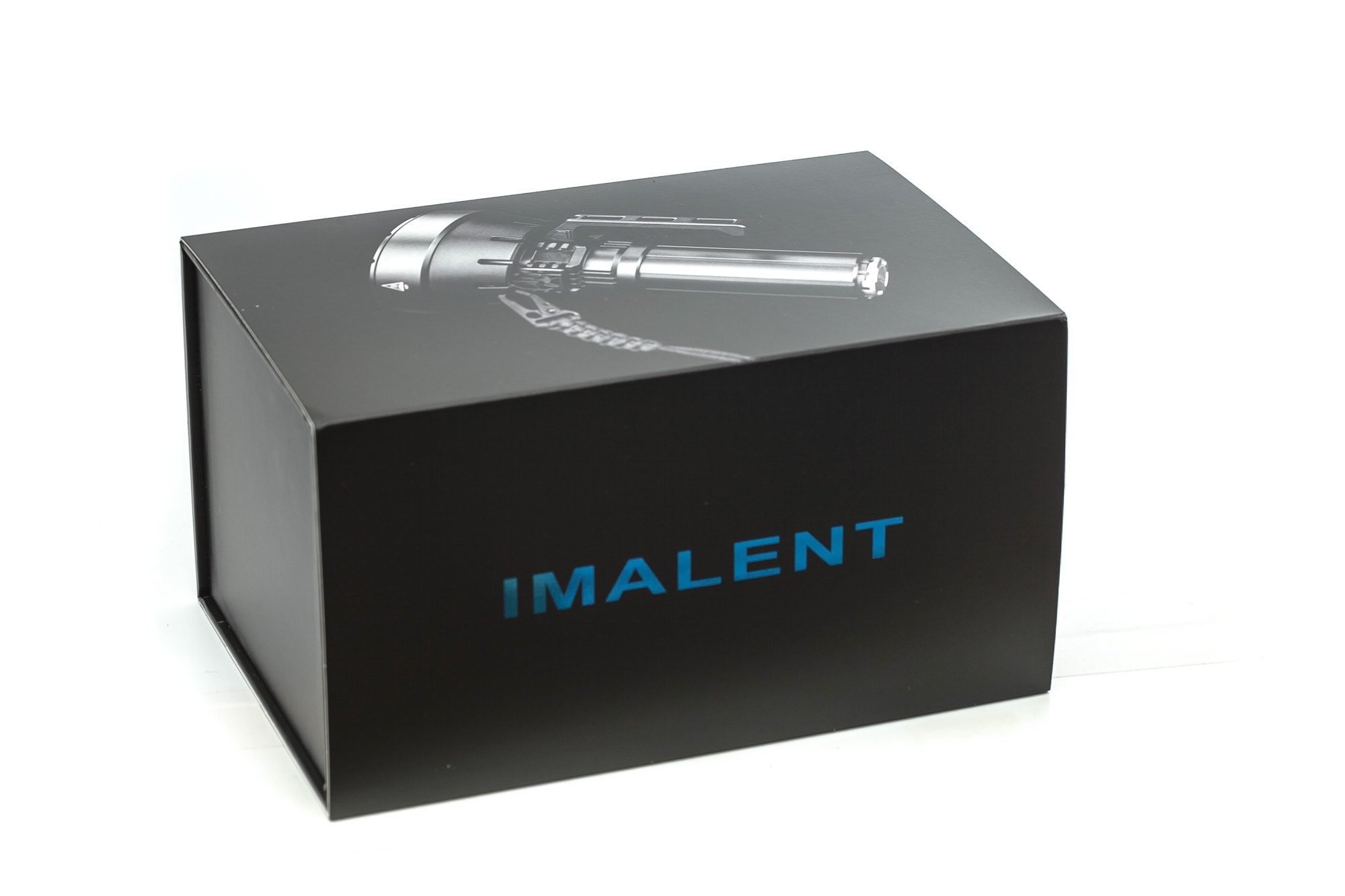
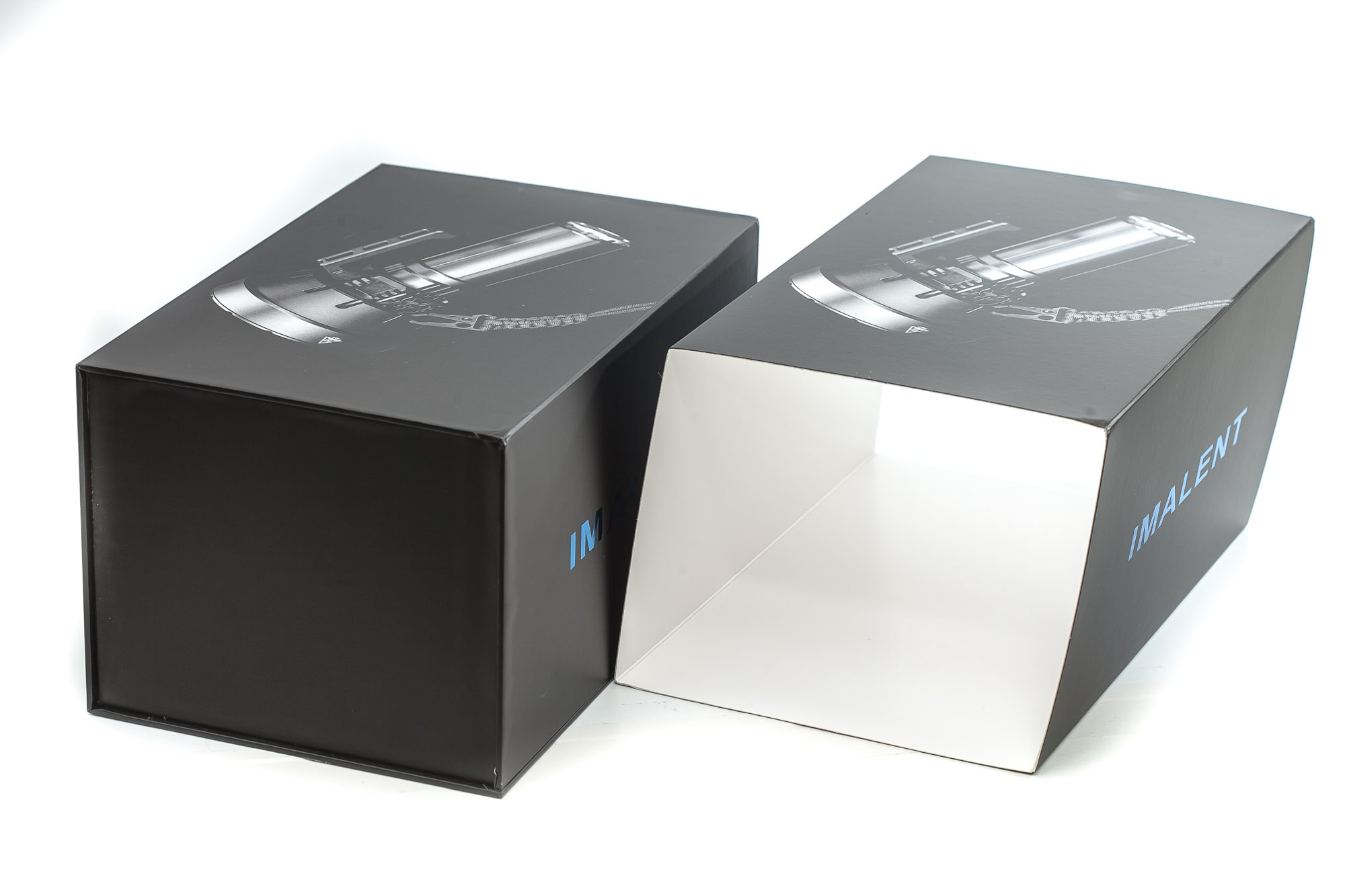
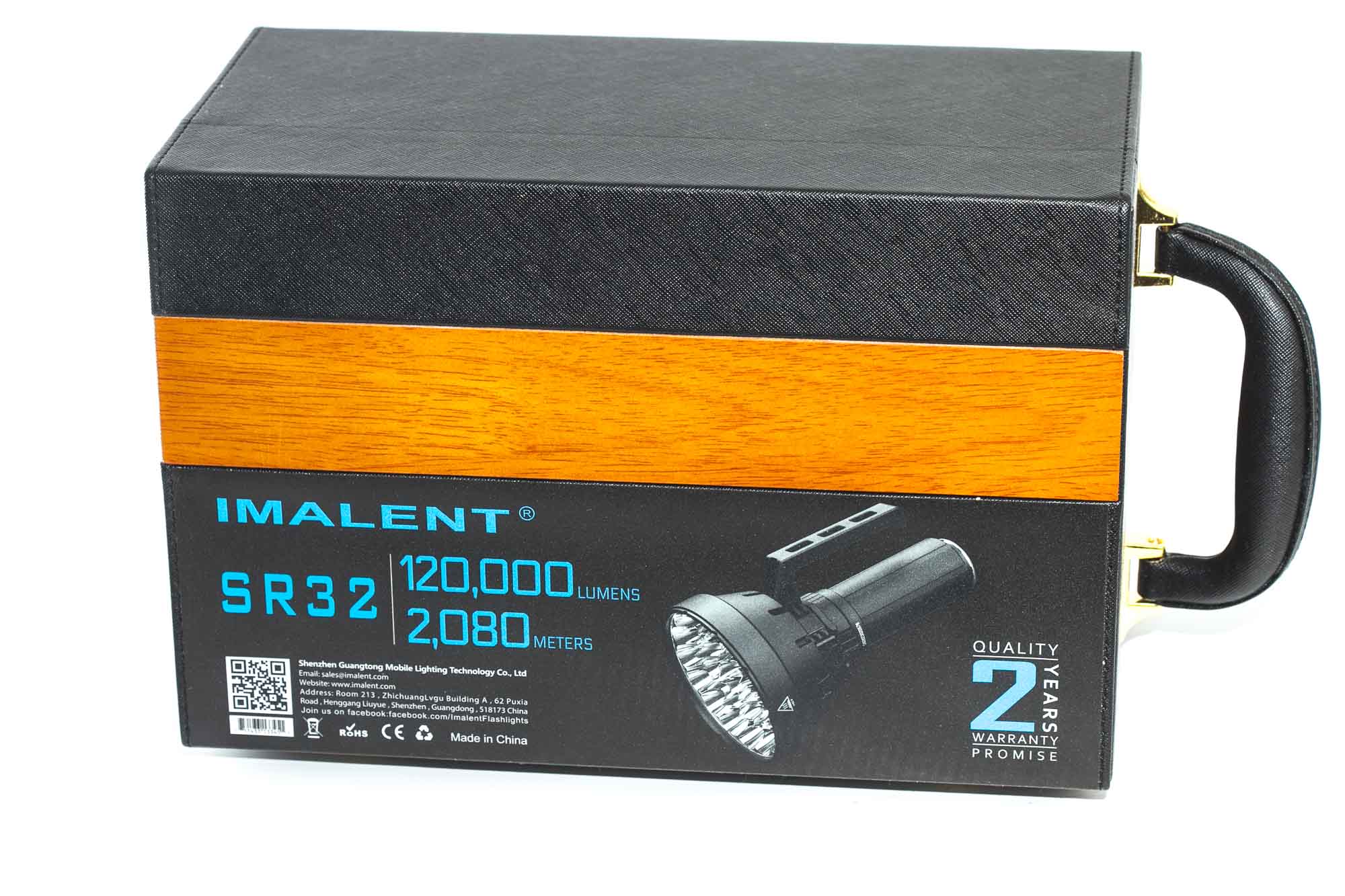
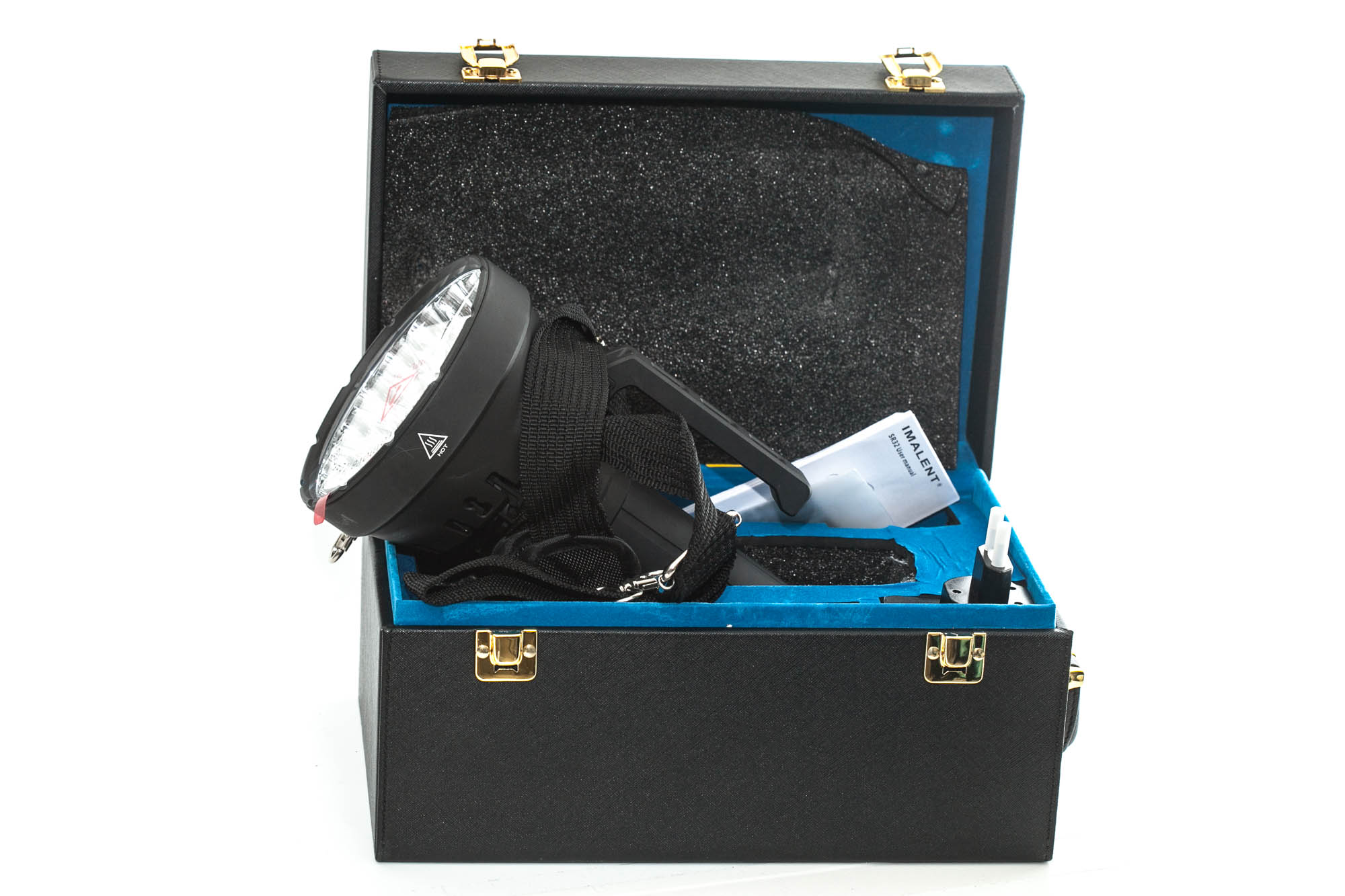
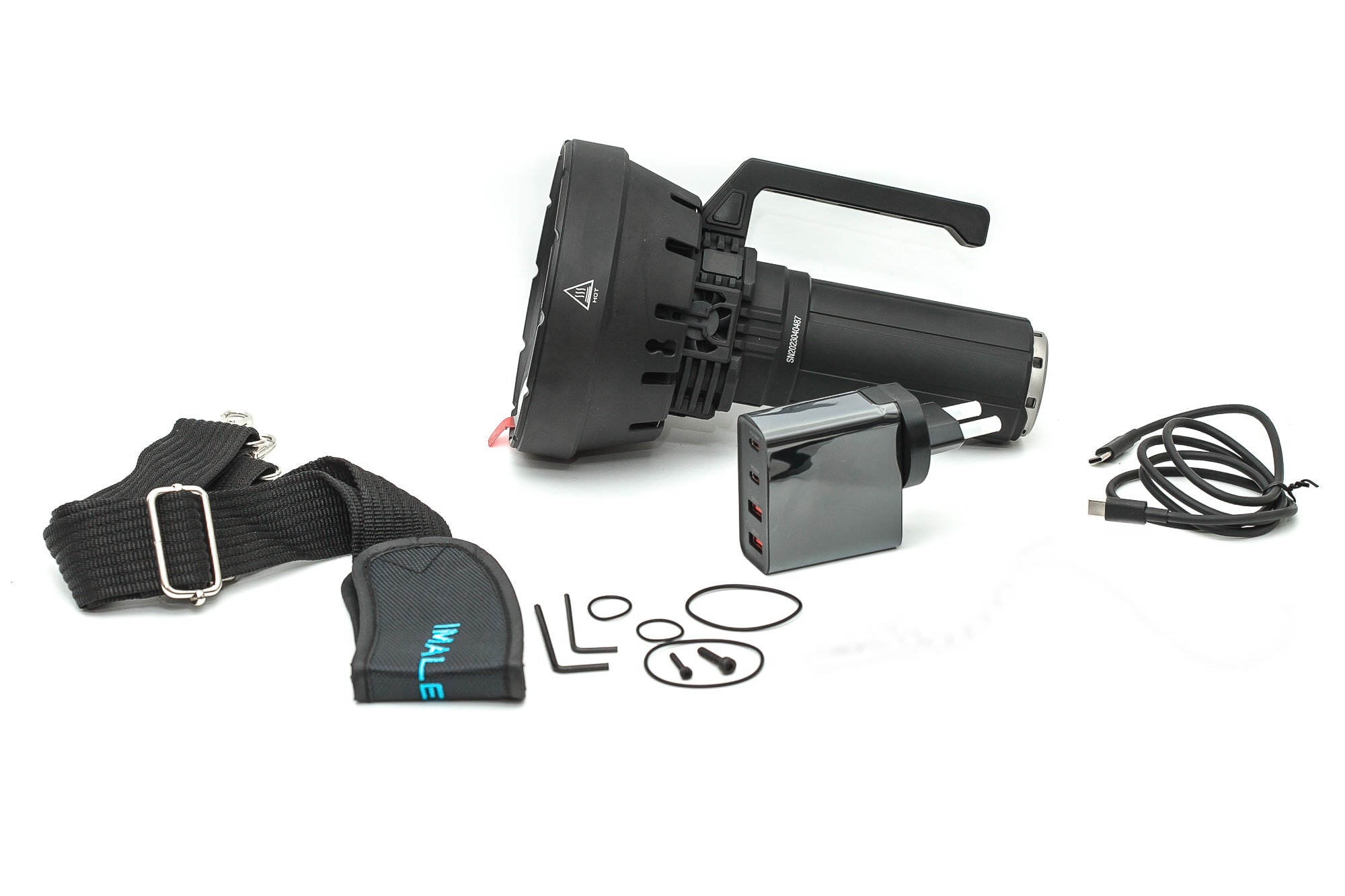
Imalent SR32 flashlight in use
Before your first use, unscrew the battery pack, to remove the battery insulator.
The SR32 includes a carry handle, with a built-in switch, which is such a great addition from the Imalent MS18, that didn’t include one and only had 1 switch. Until pretty recently, most carry handles that were shipped with flashlights (like the Acebeam X80, X80GT,etc) weren’t electronically connected to the flashlight. The handles sometimes had a fan built-in (like the Acebeam X70) but without a switch to control the flashlight. You’d had to use your other hand to change modes or turn it off.
Brands like Manker, and Acebeam started implementing switches in their handles, which is such a great feature. Now you use the light single-handedly.
Also, the switch is located on the left side of the handle, so it may not be the best choice for people who are left-handed. The switch is located in the neck of the handle, close to the body. It’s not located on top, like the Acebeam X75 or Manker MK38, and for 90% of the population (who are right-handed) that is totally fine, but it won’t be too helpful for the other 10%. You could still use your index finger to manipulate the switch on the body (if your left-handed), but that’s just a little less comfortable than using your thumb IMHO.
The flashlight itself uses an electronic switch that is located about 30 degrees from the handle, on the right side. Both switches can be used interchangeably. You can turn the light on with 1, and turn it off with the other etc. I haven’t noticed any ‘special’ features with either of them.
Imalent has changed the switch location on the body, which is a bit easier to find in the dark, but it’s still not as big as I hoped.
The flashlight is housing 8*21700 batteries resulting in a pretty wide battery pack, so I like the carry handle a lot. If you don’t like it, you can simply remove it, because there is another switch, located on the body itself.
Plus, another benefit is that it serves as an anti-roll feature. You don’t want to have this light roll of a table, and fall on your foot.
The tailcap uses a flat charge-port cover, so you can make it tail stand.
One thing I still missed though, and that’s a proper tripod mount. Especially with this size flashlight, they should have included one.
Imalent says they updated the fans, but the fans are still very noisy. There are 3 of them, and 2 are sucking the air onto the body, while the third one is blow out the hot air.
There is also a small LCD screen, showing the current mode. This screen is lit for only 5 seconds before it turns off. When the light is turned off, you can’t turn on the display to see what mode is currently memorized.
As far as the UI goes, I’m not too happy with the UI.. it seems to be made without some important considerations for such a high power flashlight. Keep reading!
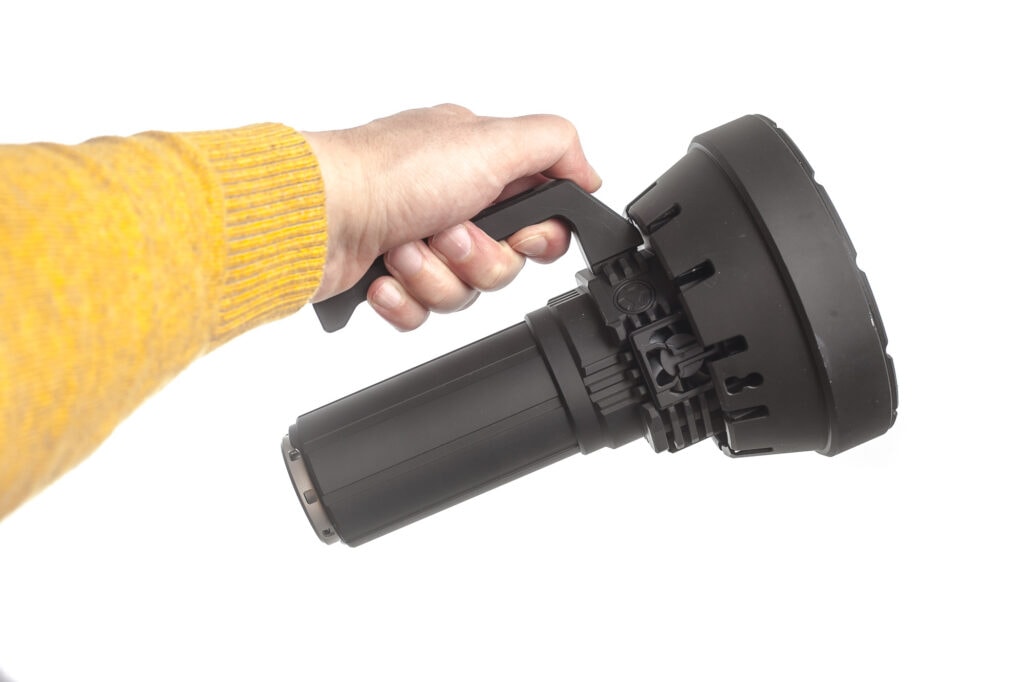
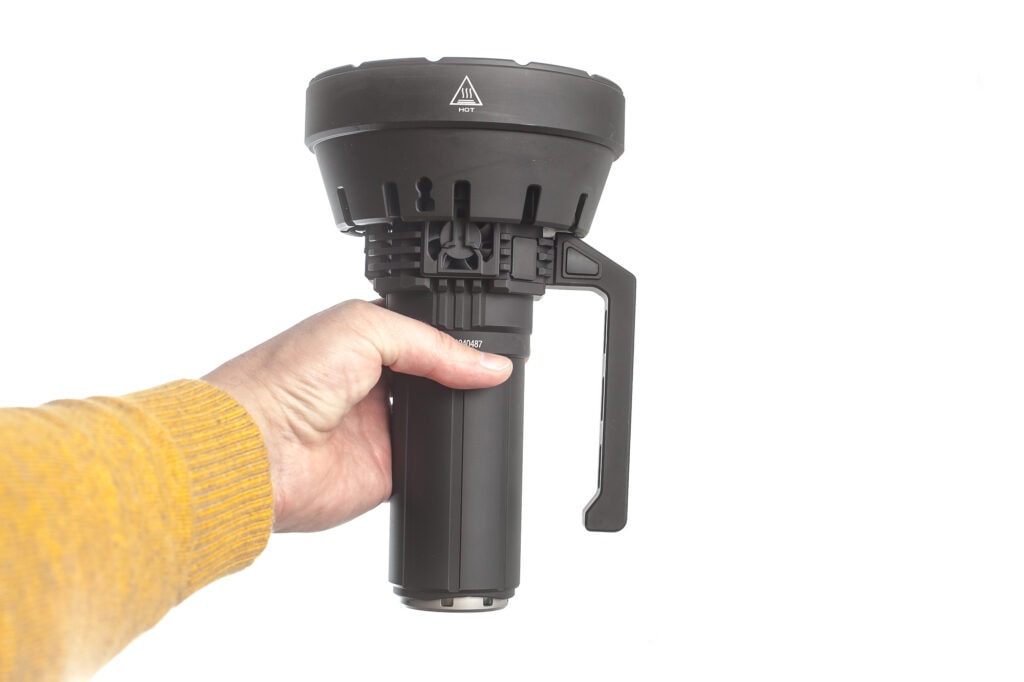

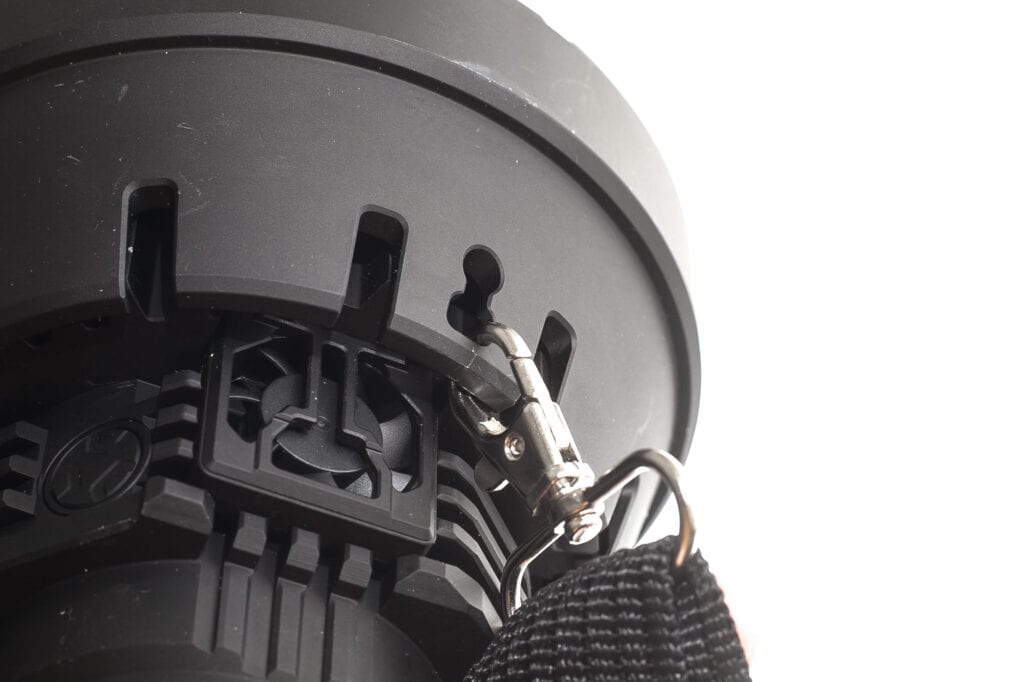
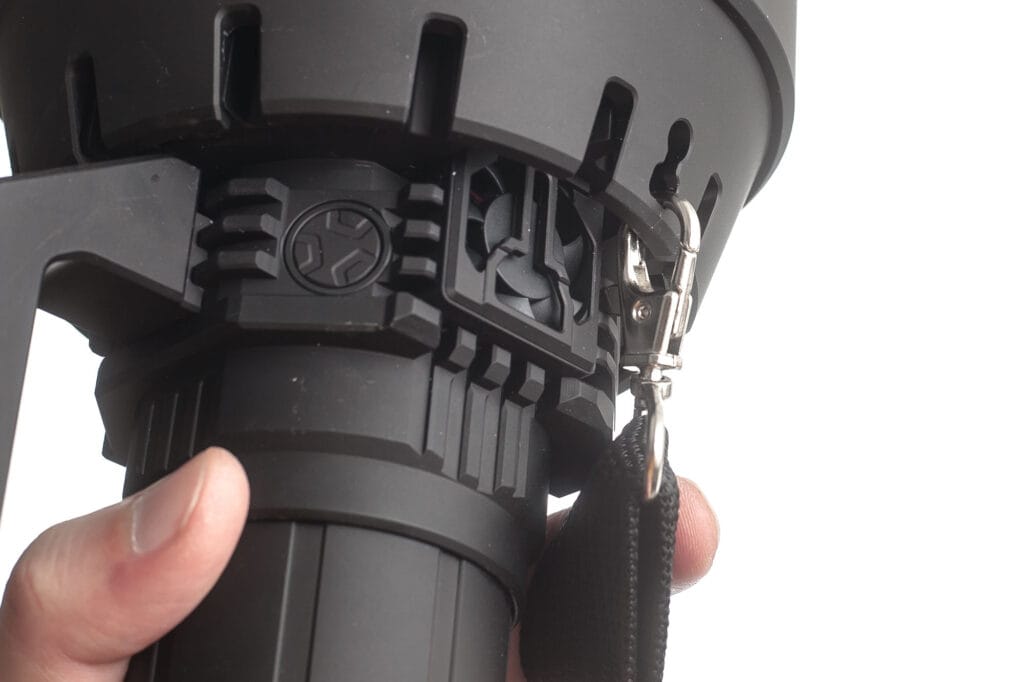
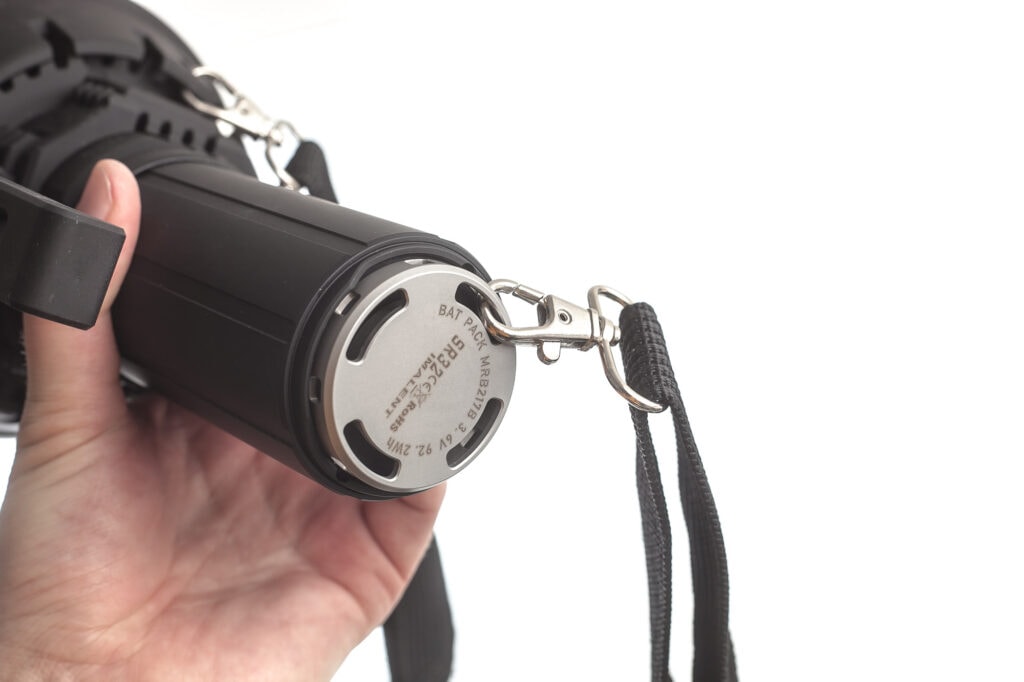
Build Quality, and Warranty
Imalent’s build quality is good with all off their recent lights, and the SR32 is no exception.
Imalent is using a new type of anodization for the SR32. The battery tube is smooth, without any knurling, but has a very matte finish. It doesn’t make the flashlight feel slippery, but I’d surely would have appreciated some sort of knurling.
The downside of this coating is its shows spots like fingerprints very easily. You can see that in my unboxing video here.
The handle is adequately strong, and has a switch built into it. When removed, it exposes 2 pogo pins, and they removed the little red battery indicator, that was found on the smaller SR16. Another uses pointed out that his handle arrived loose, and had to tighten it.
With the handle installed, you get a switch on the left side of the handle, and the main switch on the body on the right-hand side. If you’re left handed, you could possibly use your index finger to manipulate the main switch, but it’s definitely geared towards right-handed users.
There’s a USB-C charging port in the tailcap, covered with a metal flat screw-on plate. This makes the SR32 able to tailstand.. but not too stable.
The battery tube unscrews relatively easy, but with the o-ring you need to pull the battery pack out, otherwise you’ll keep unscrewing endlessly. The o-ring makes it stay in place.
Imalent’s warranty (from their website)
- Free Repair/Replacement within 15 Days after Receipt
Within 15 days after receipt and under normal use, any quality problem with your IMALENT flashlight, you can either send the light to repair or a new one of the same type with same specifications will be replaced; if the same model has been discontinued or not able to be replaced timely due to other reasons, another model with same or better performance will replaced instead;
24 Months’Free Repair
Within 24 months after receipt and under normal use, any quality problem with your IMALENT flashlight, you can send it to repair for free;
Torch with built-in battery and battery stick, 12 months warranty.
(This used to be 60 months not long ago, so this has changed!)
Lifetime Limited Maintenance
IMALENT provides you with lifetime limited maintenance for your flashlight, after the 24 months free repair period, any probems with your flashlight, IMALENT can repair and maintain it,repairing fee will be charged on an actual cost basis, no labor cost charged;
The warranty is nullified in all of the following situations:
- The product(s)is/are broken down, reconstructed nd/or modified by unauthorized parties.
- The product(s) is/are damaged through improper use.
- The product(s) is/are damaged by leakage of batteries.
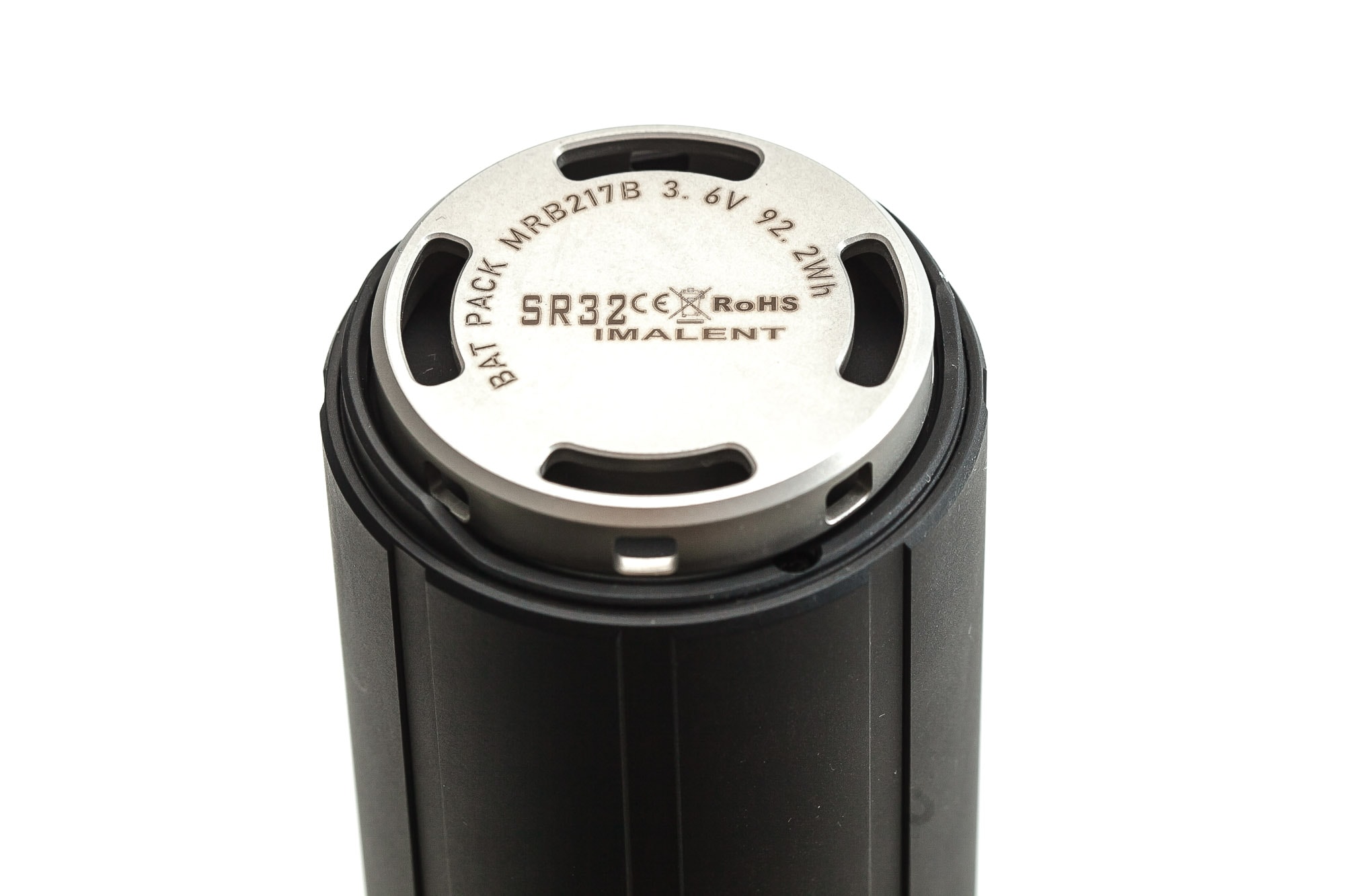
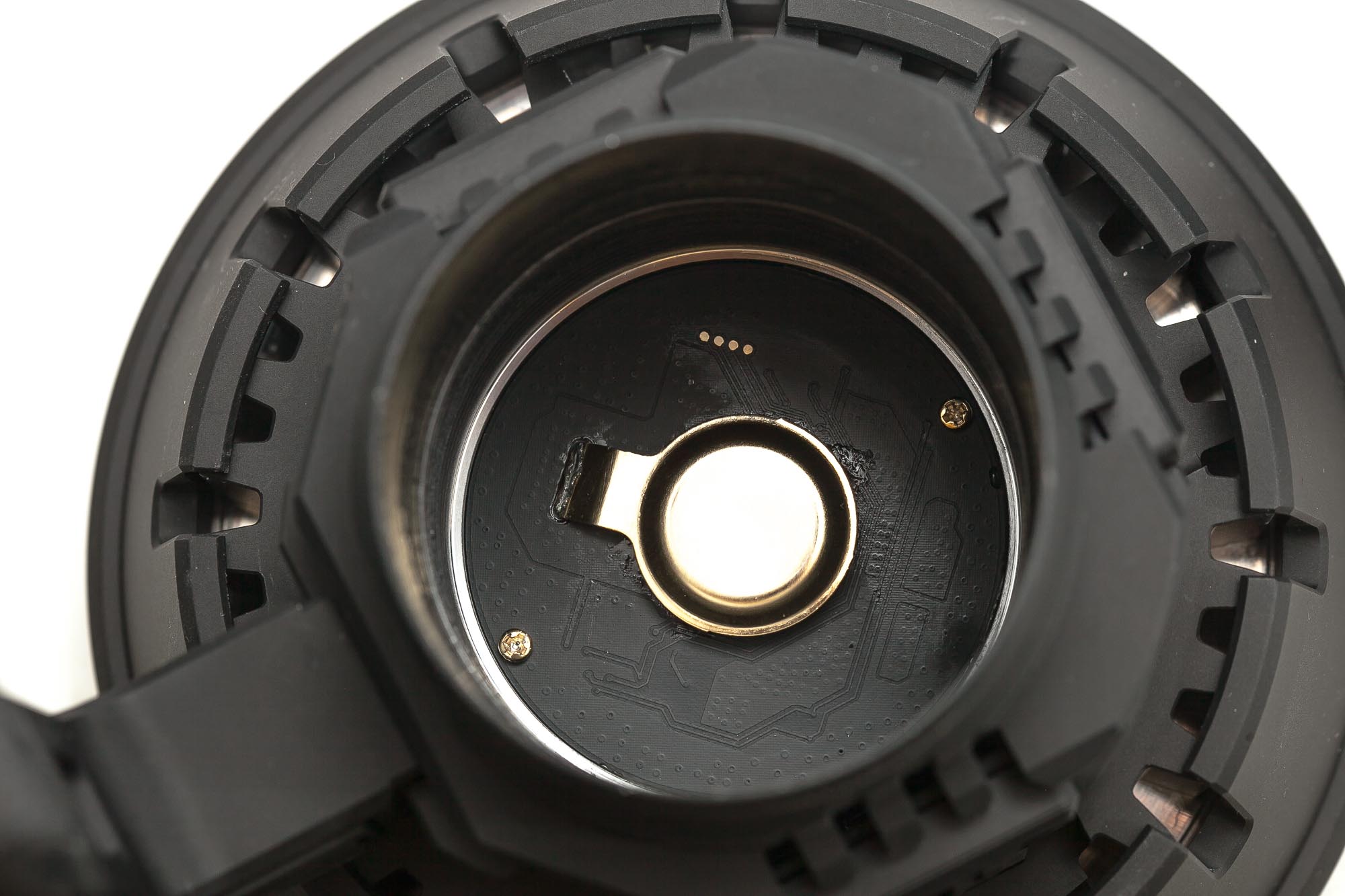
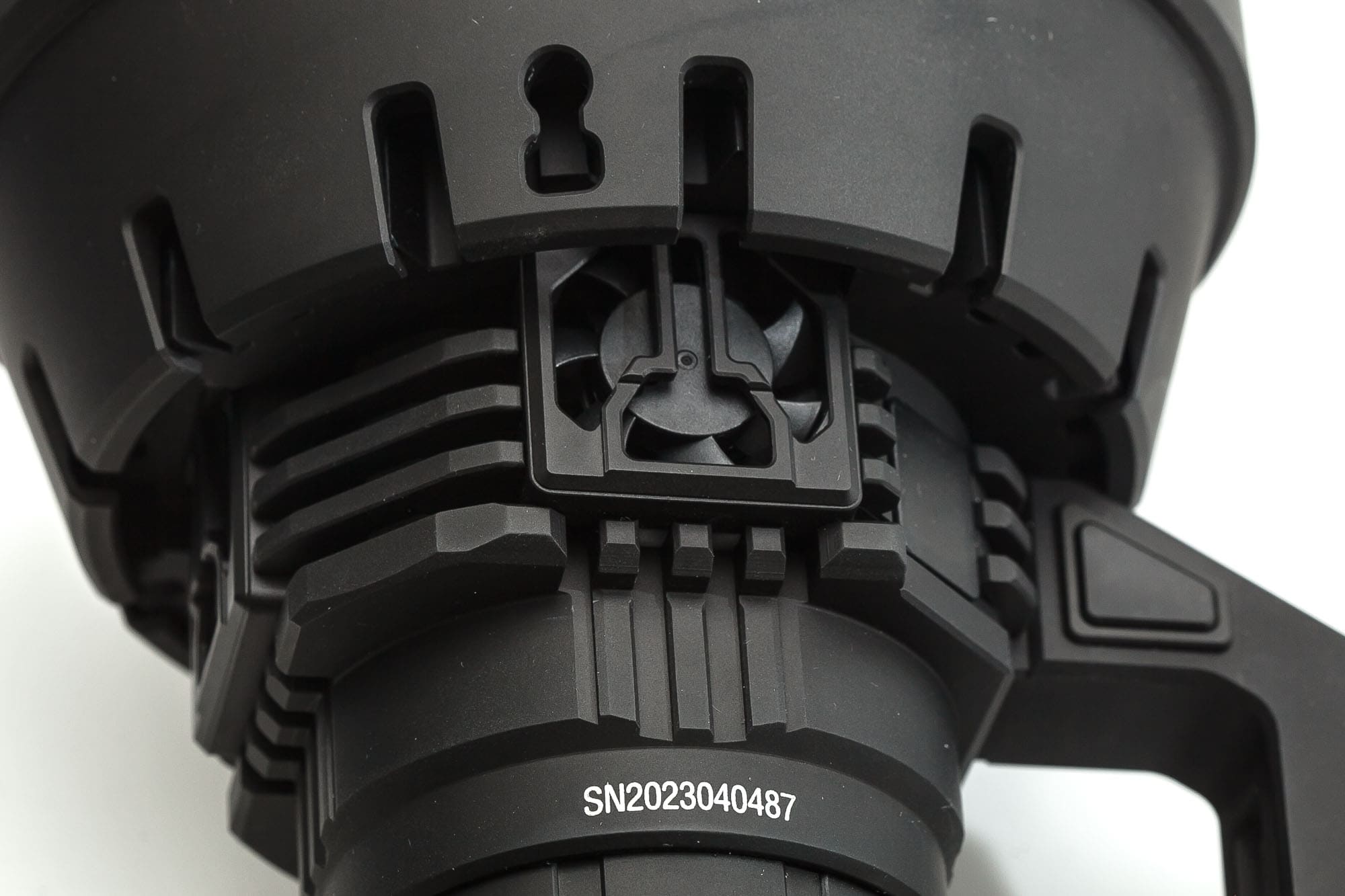
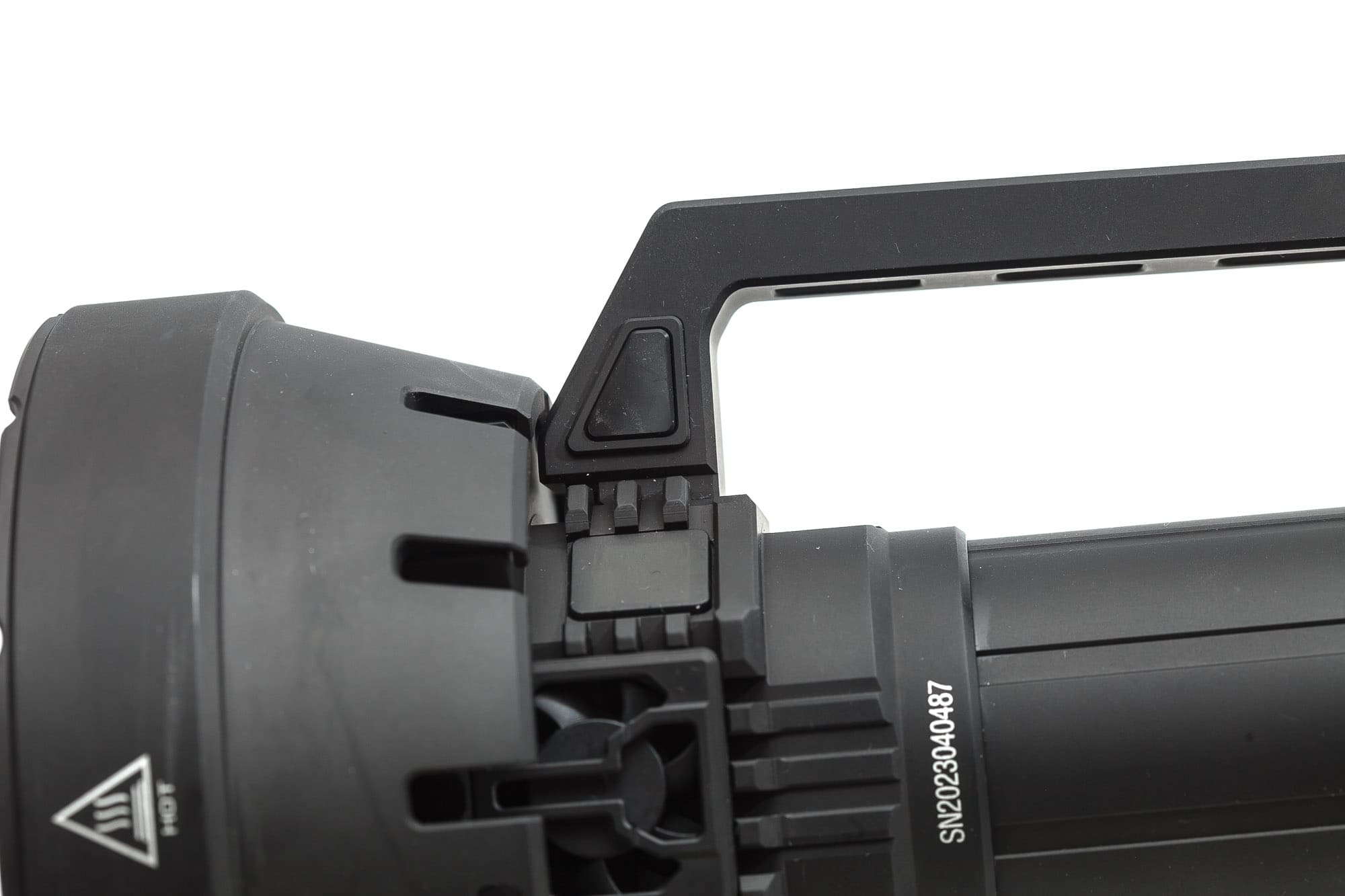
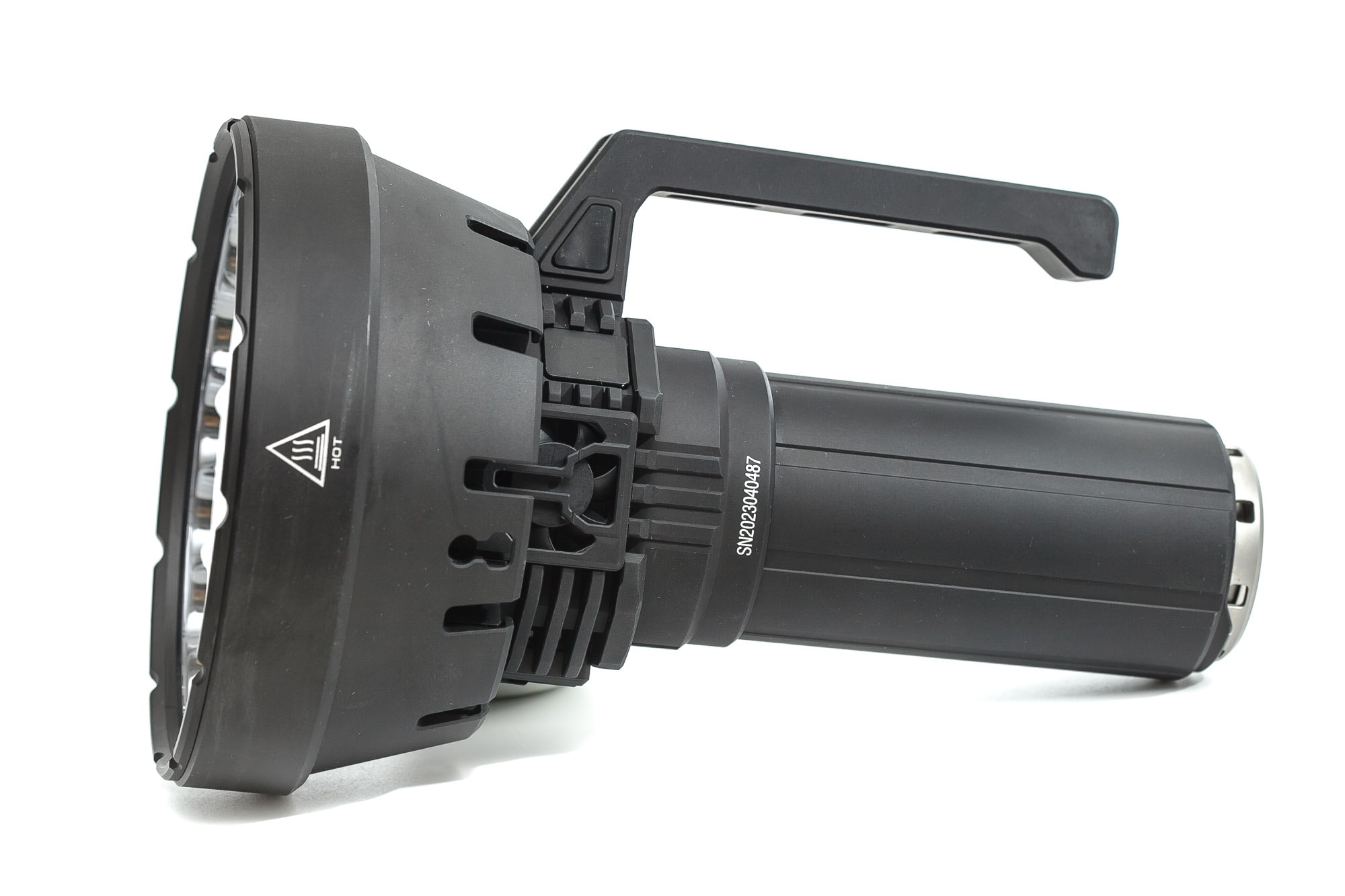
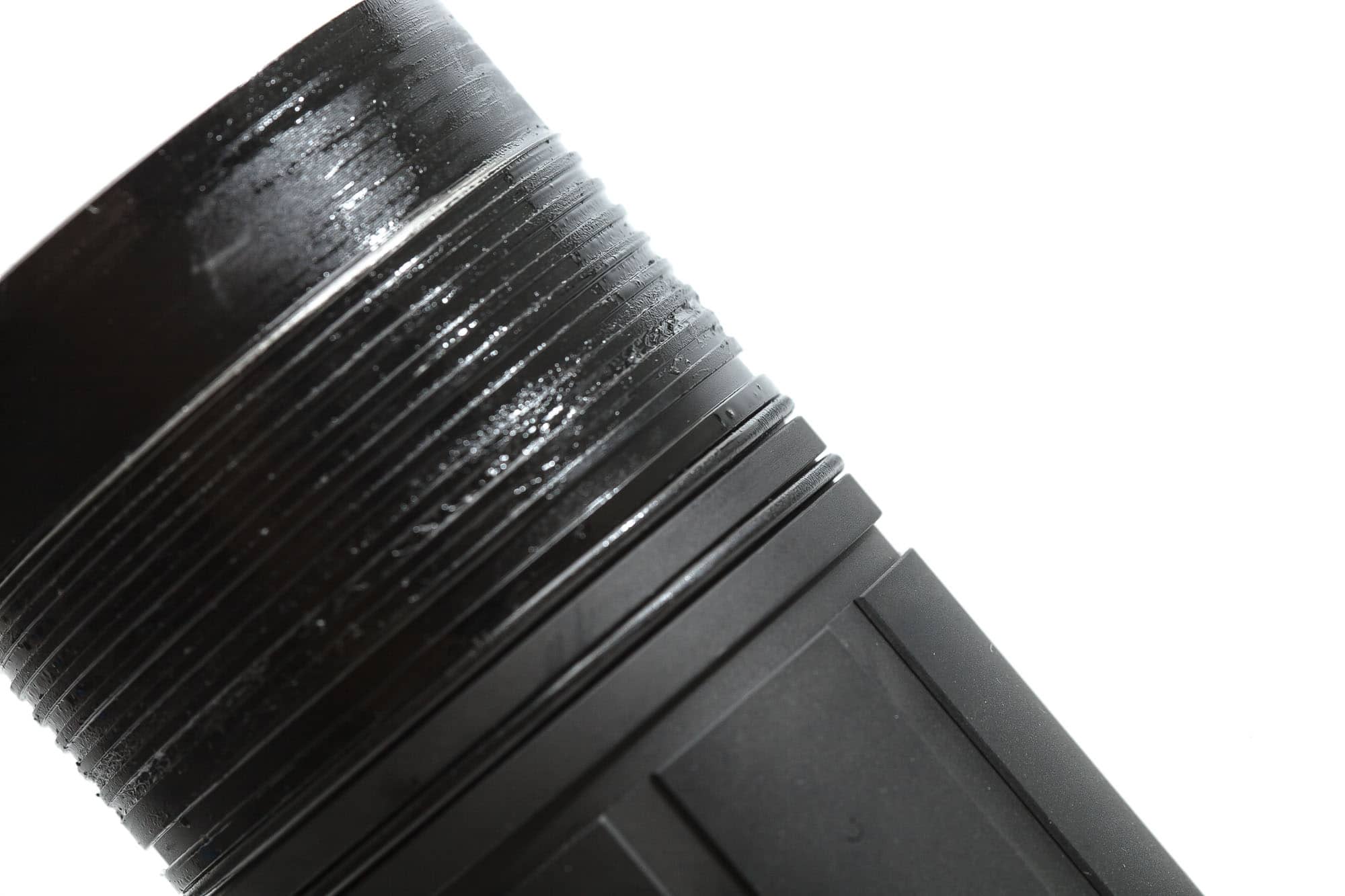
LED, Lens, Bezel, Beam, and Reflector
Unlike many of Imalent’s other offerings of its high-power flashlights, they went again with the CREE XHP50.3 Hi LEDs, just like its little sibling, the SR16. Most other high-power flashlights use CREE XHP70.2’s or 70.3’s. The CREE XHP50.3 hi however, is a great combination of power and intensity. And if you didn’t know, Hi stands for high intensity.
All LEDs are perfectly centered in 32 shallow, smooth reflectors. And even though XHP50.3 Hi LEDs are throwy, the shallow reflectors turn the beam into a combination of great throw and flood.
The reflector is protected by a glass lens, with AR coating, which is again protected by a relatively flat bezel, with several small cutouts.
I used the Asensetek Lighting Passport Pro Standard for measuring the following. I measured at 5 meters distance, soon after turn on. The flashlight was handheld as there was no place to put it down.
| Mode | CCT | CRI Ra | Duv |
|---|---|---|---|
| Moon (30lm) | 6240K | 69 | 0.0141 |
| Middle Low (4,500lm) | 6351K | 71 | 0.0077 |
| Middle II (25,000lm) | 6167K | 70 | 0.0094 |
| Turbo (120,000lm) | 6623K | 69 | 0.0055 |
The spectrometer showed some kind of error that ‘the brightness” in the lowest mode could give incorrect results. So keep that in mind when looking at the data!
Even though the highest setting didn’t give an error, in earlier measurements anything too bright would have resulted in an error as well.
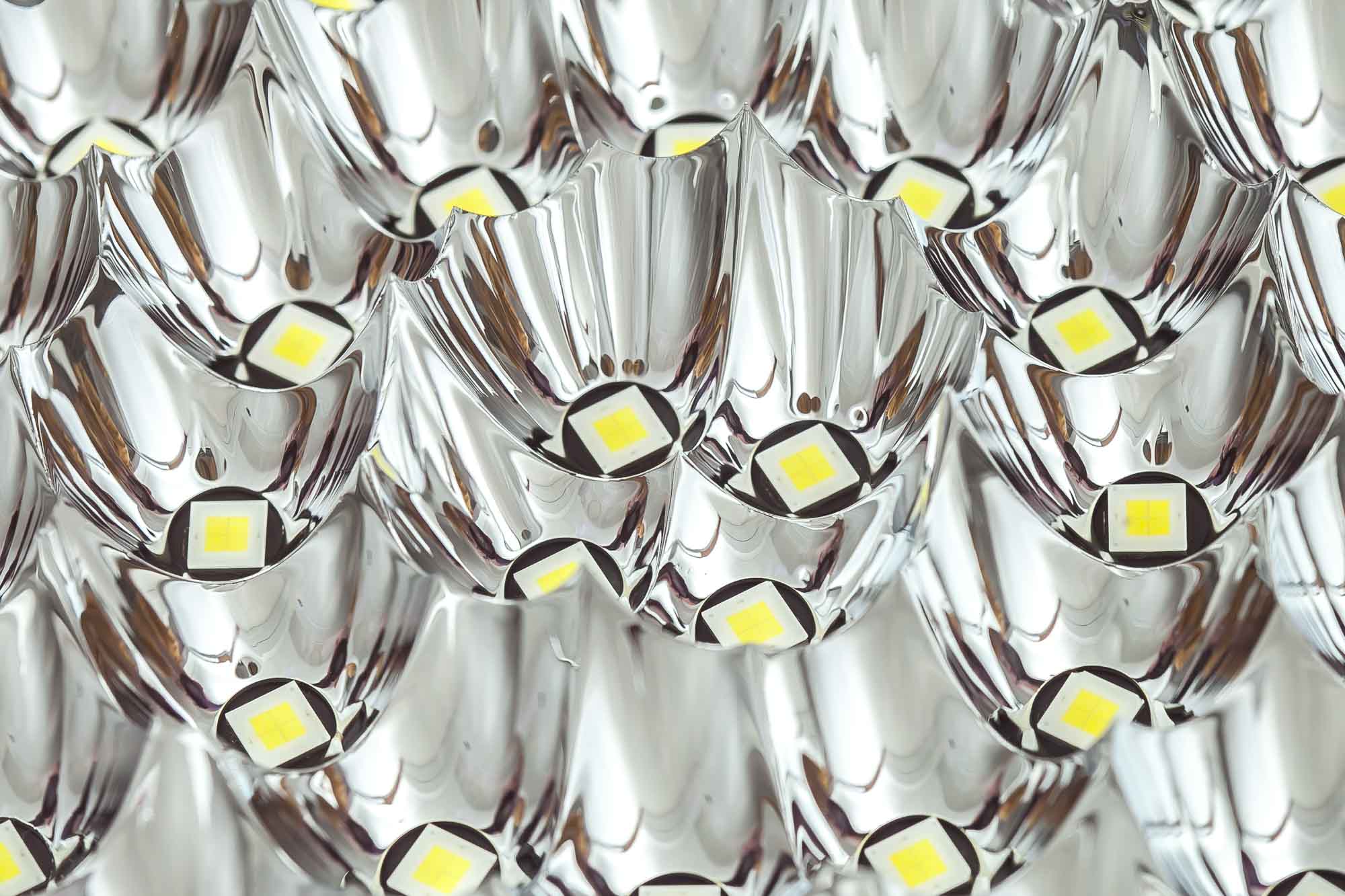
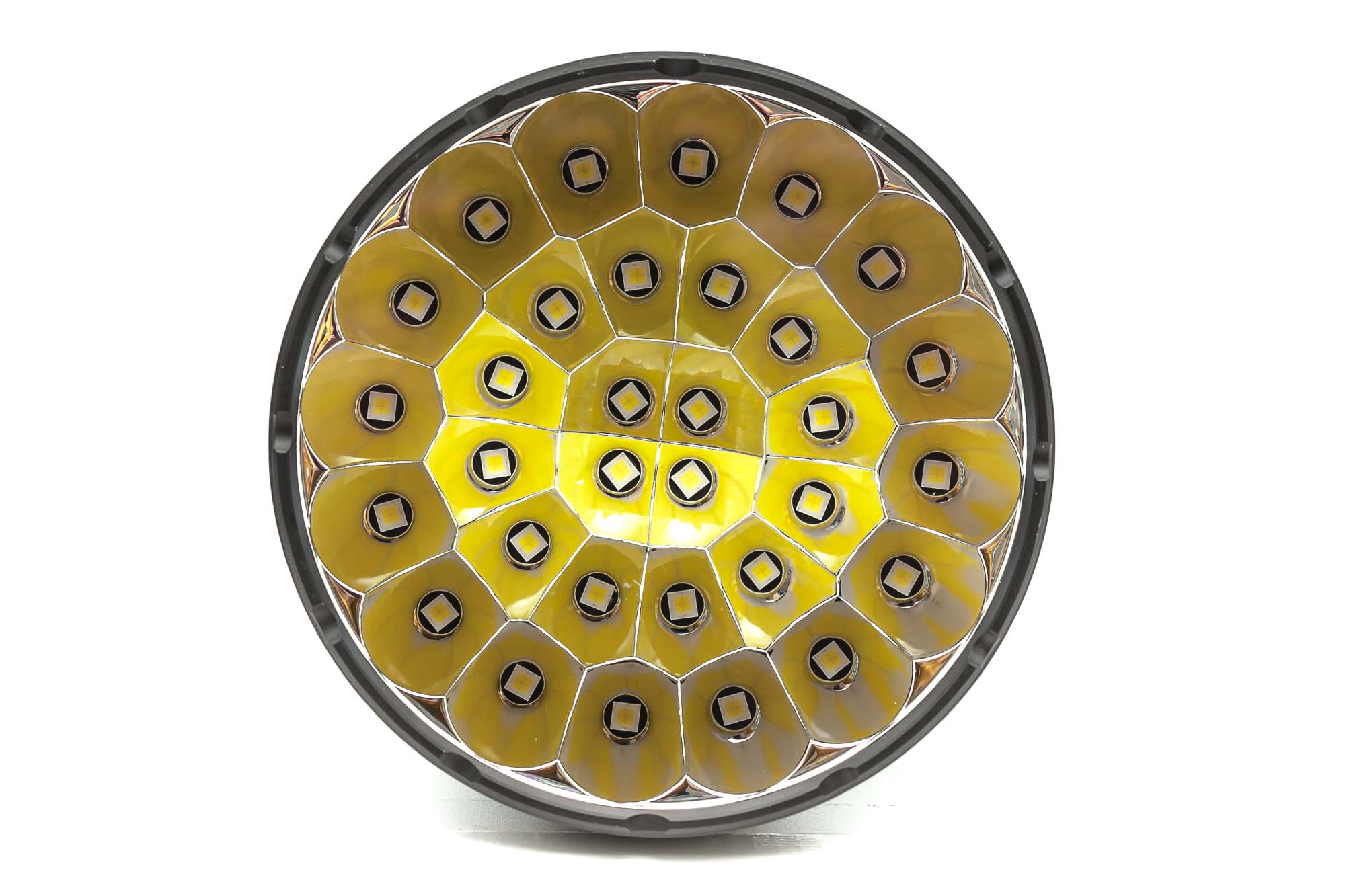
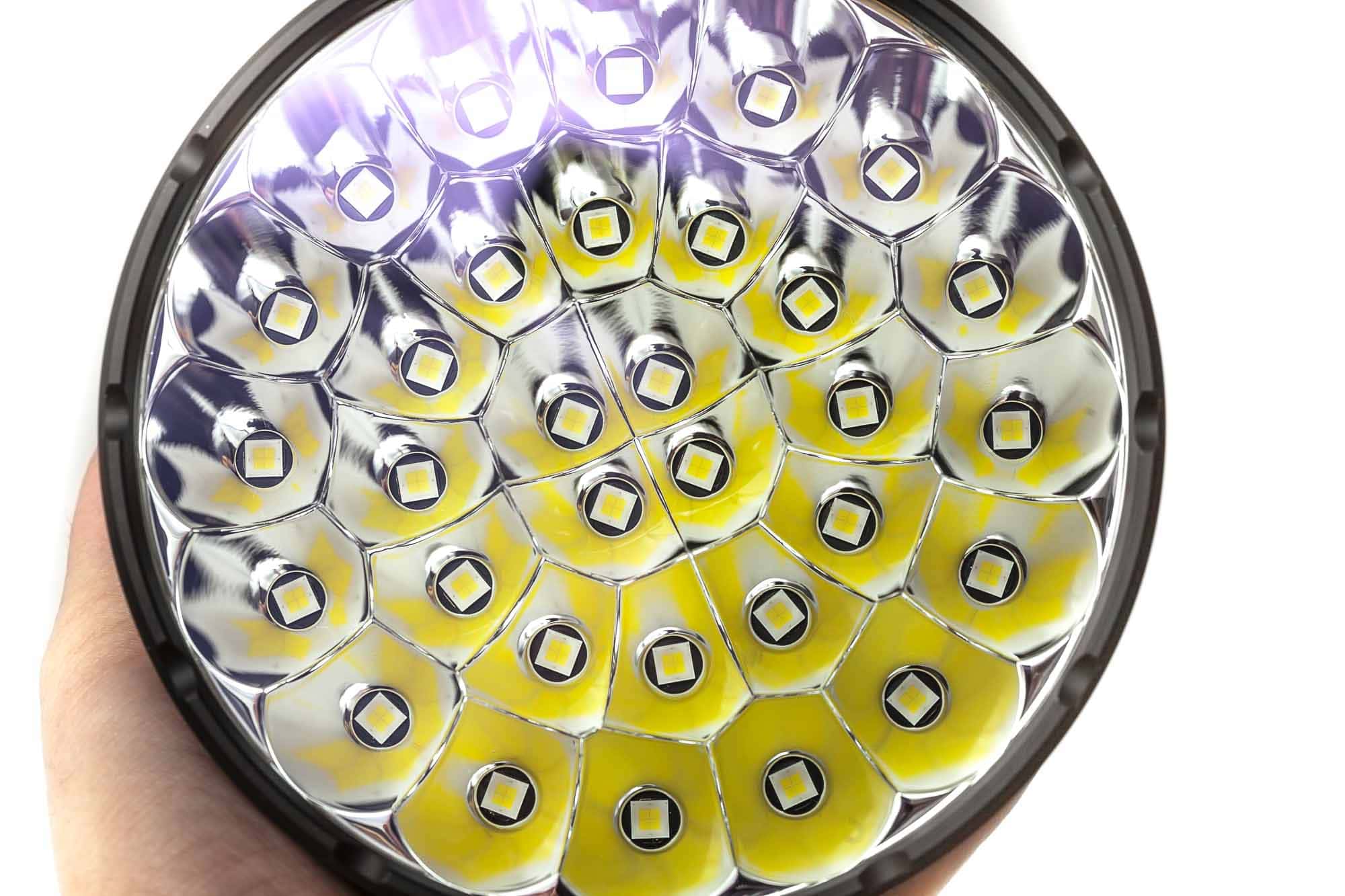
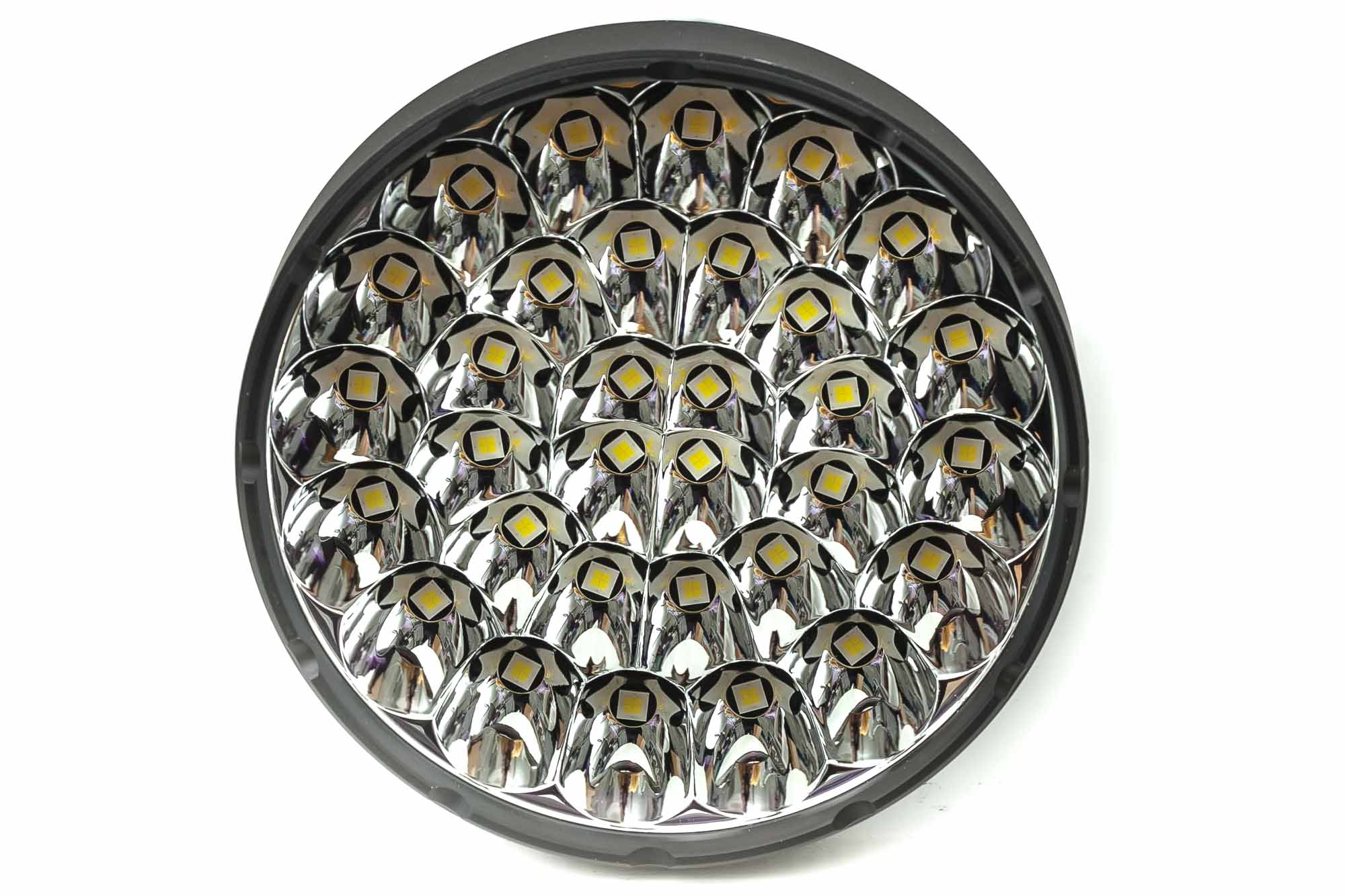
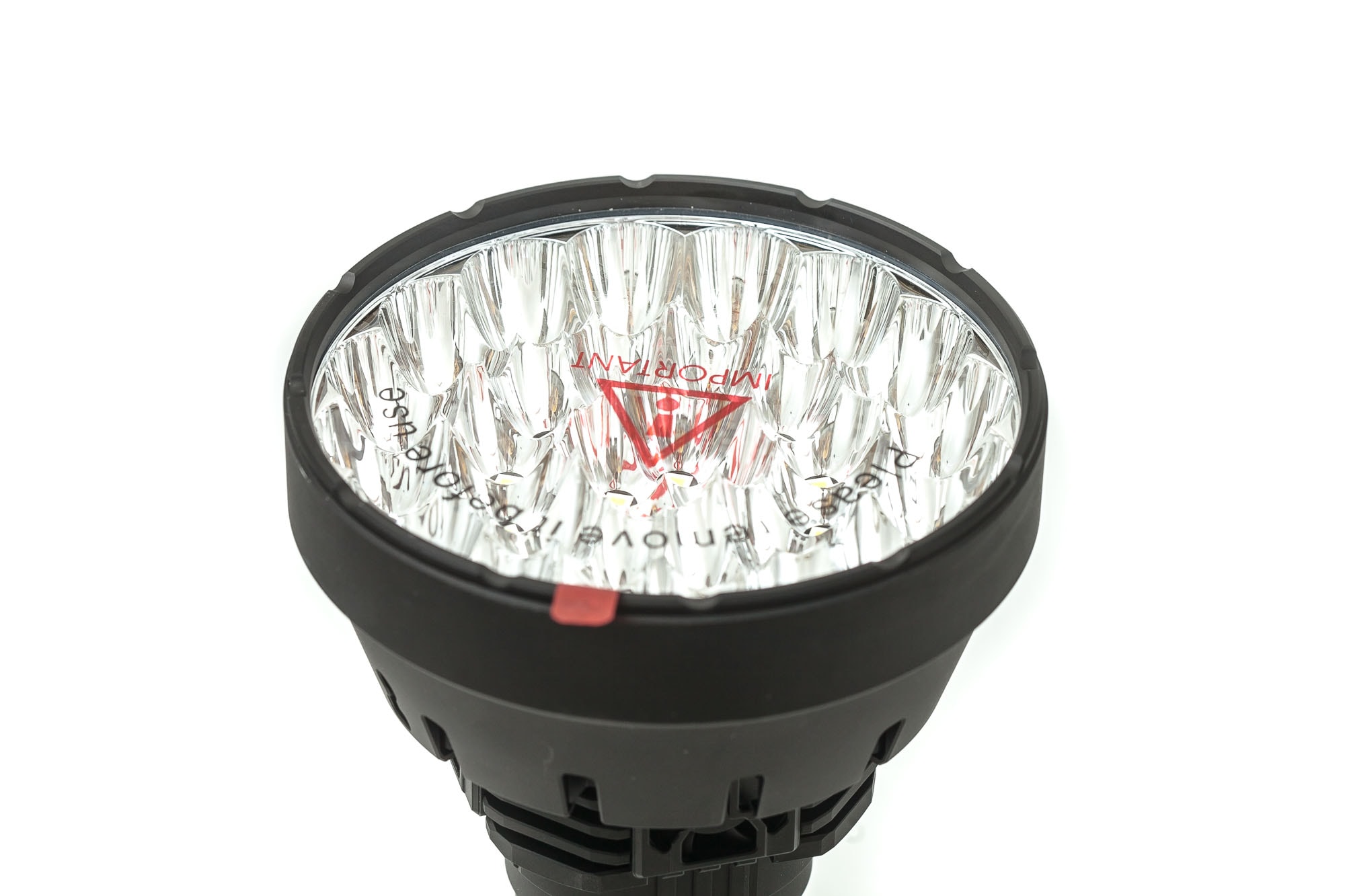
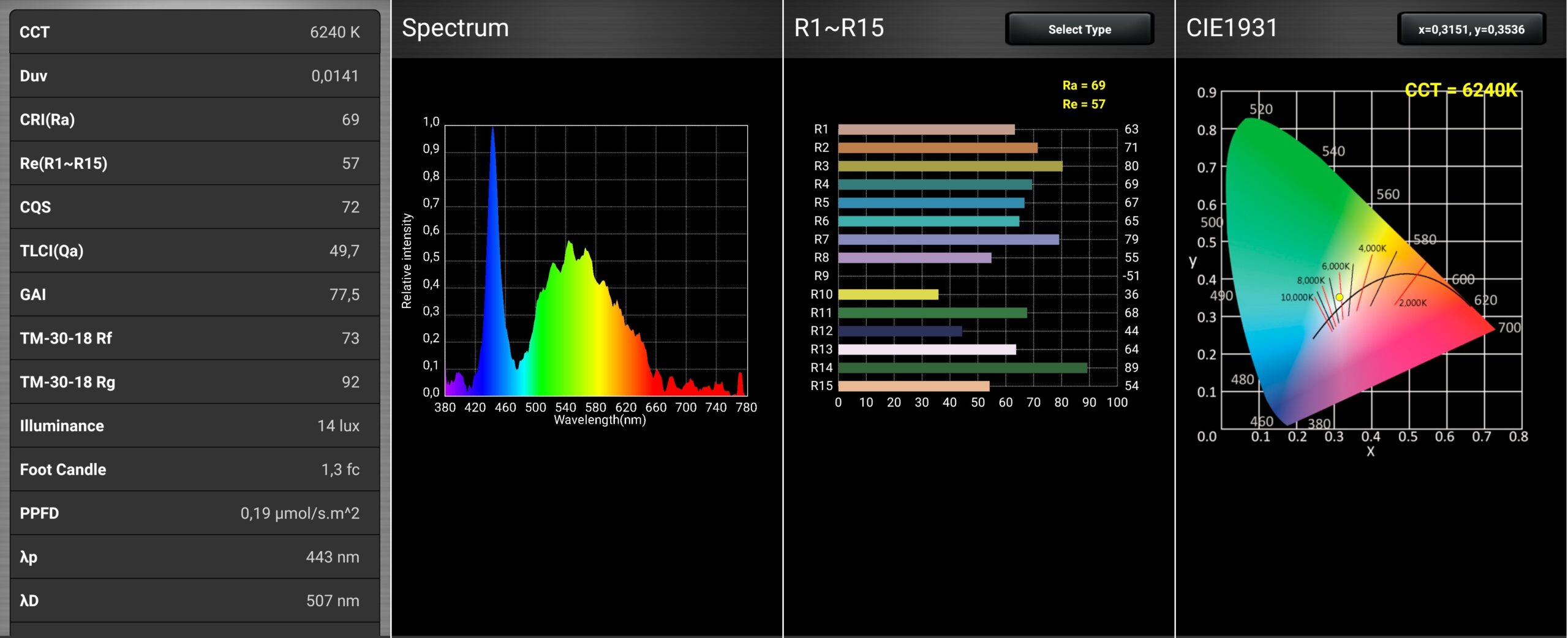
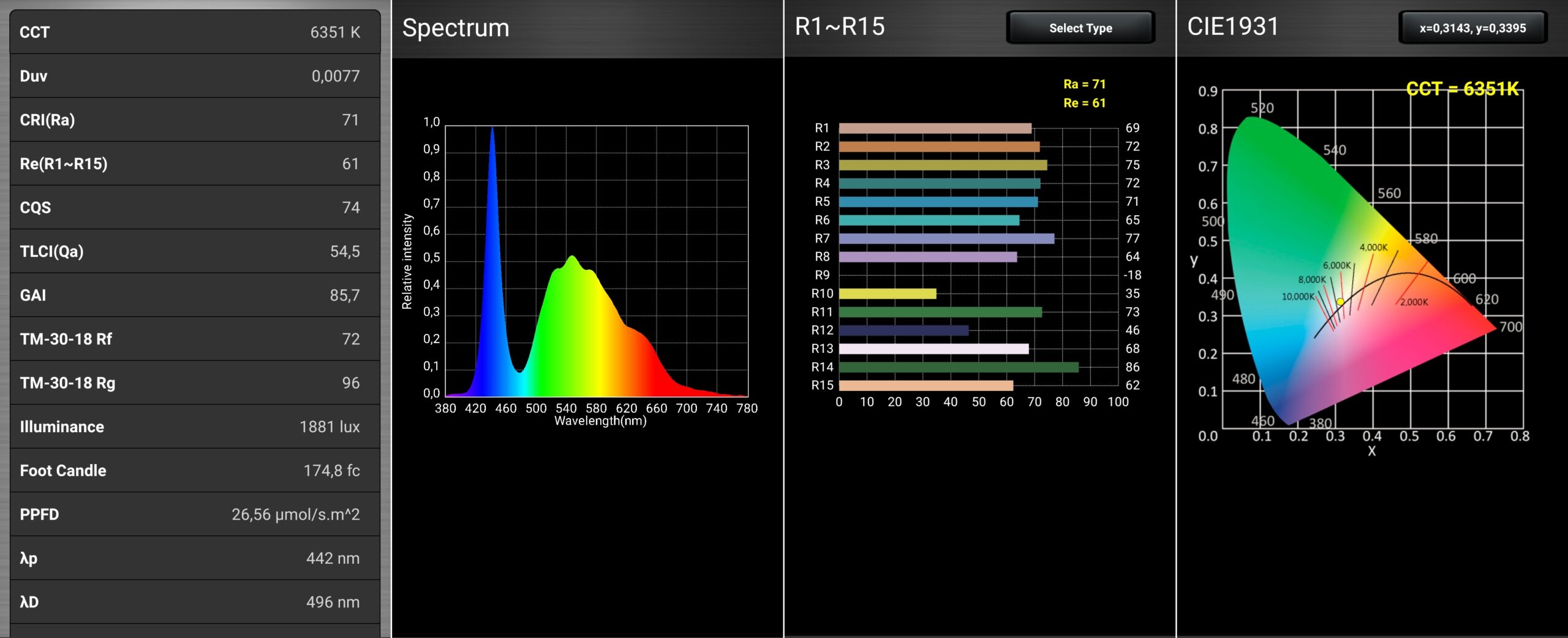
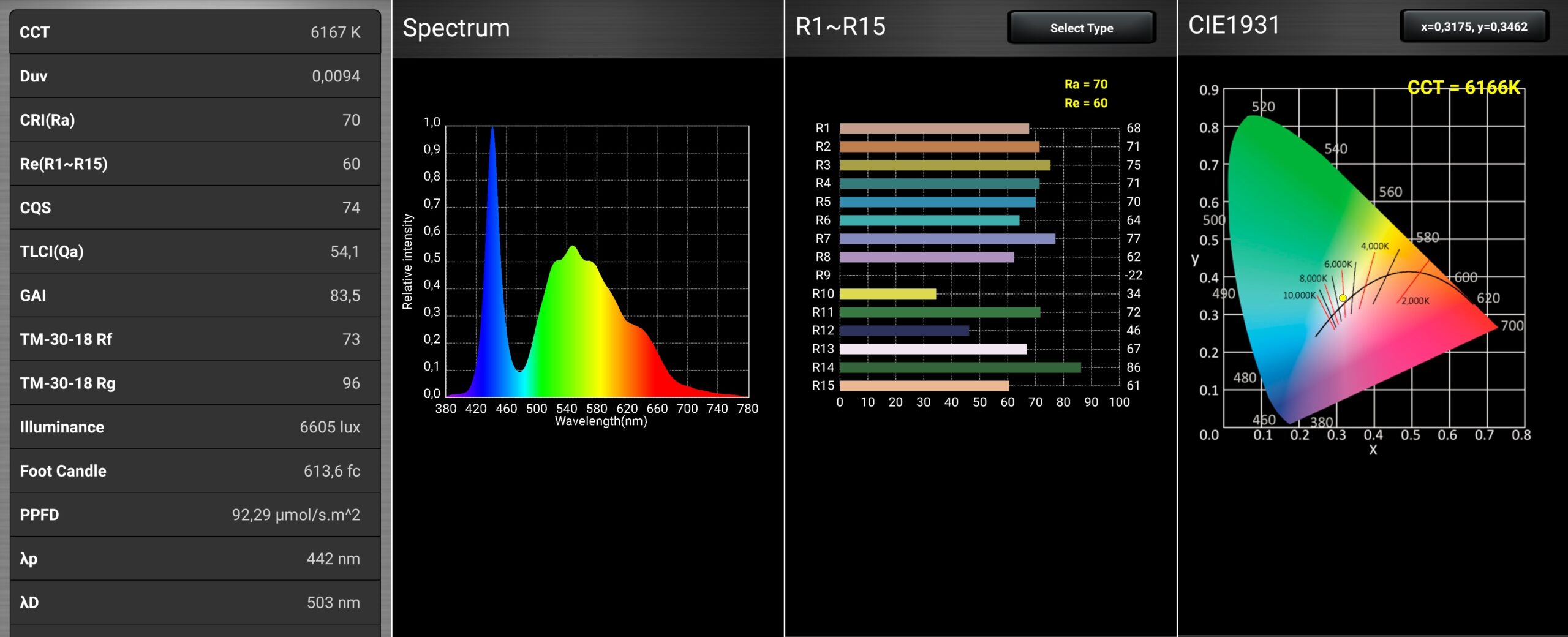
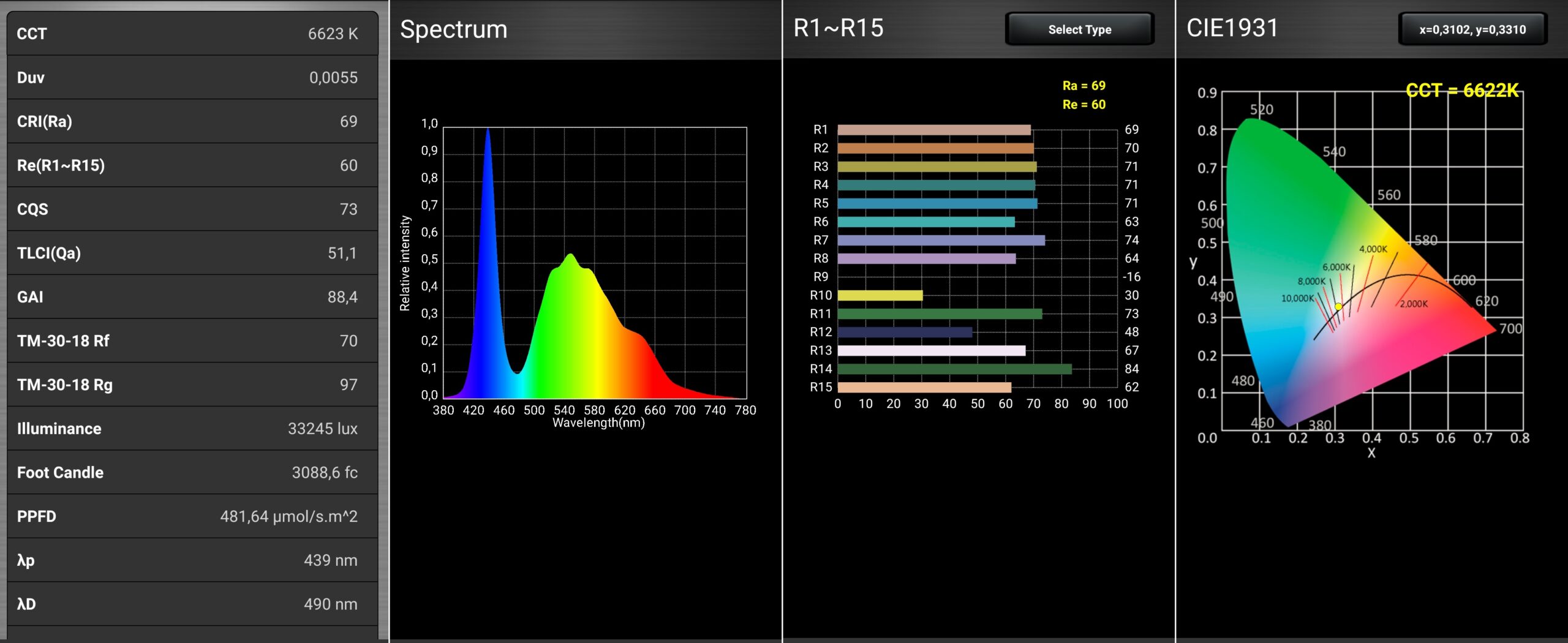
Dimensions and size comparison
Dimensions:
| Imalent SR32 | Millimeters | Inches |
|---|---|---|
| Length | 222 mm | 8.7 in |
| Head diameter | 138 mm | 5.4 in |
| Body diameter | 57 mm | 2.2 in |
Dimensions are rounded to the nearest millimeter, and to the nearest tenth of an Inch.
Weight:
| Imalent SR32 | Weight in grams | Weight in Oz. |
|---|---|---|
| Head + handle | 1,330 g | 46.9 oz |
| Battery pack | 843 g | 29.7 oz |
| Complete | 2,173 g | 76.7 oz |
Weight is rounded to the nearest gram, and to the nearest tenth of an Oz.
High Power flashlights comparison
Size compared to other high lumen flashlights, and the world’s most powerful flashlights
Backrow: Imalent MS12, Lumintop GT94X, Acebeam X70, Wuben A1.
Left 3: Imalent MS12, Imalent MS18, and Acebeam X50 in front
Imalent SR32 in the middle, lying down.
Right 3: back: Acebeam X75, Imalent MS08, and front Imalent SR16
Group 2: Imalent MS18 vs Imalent SR32
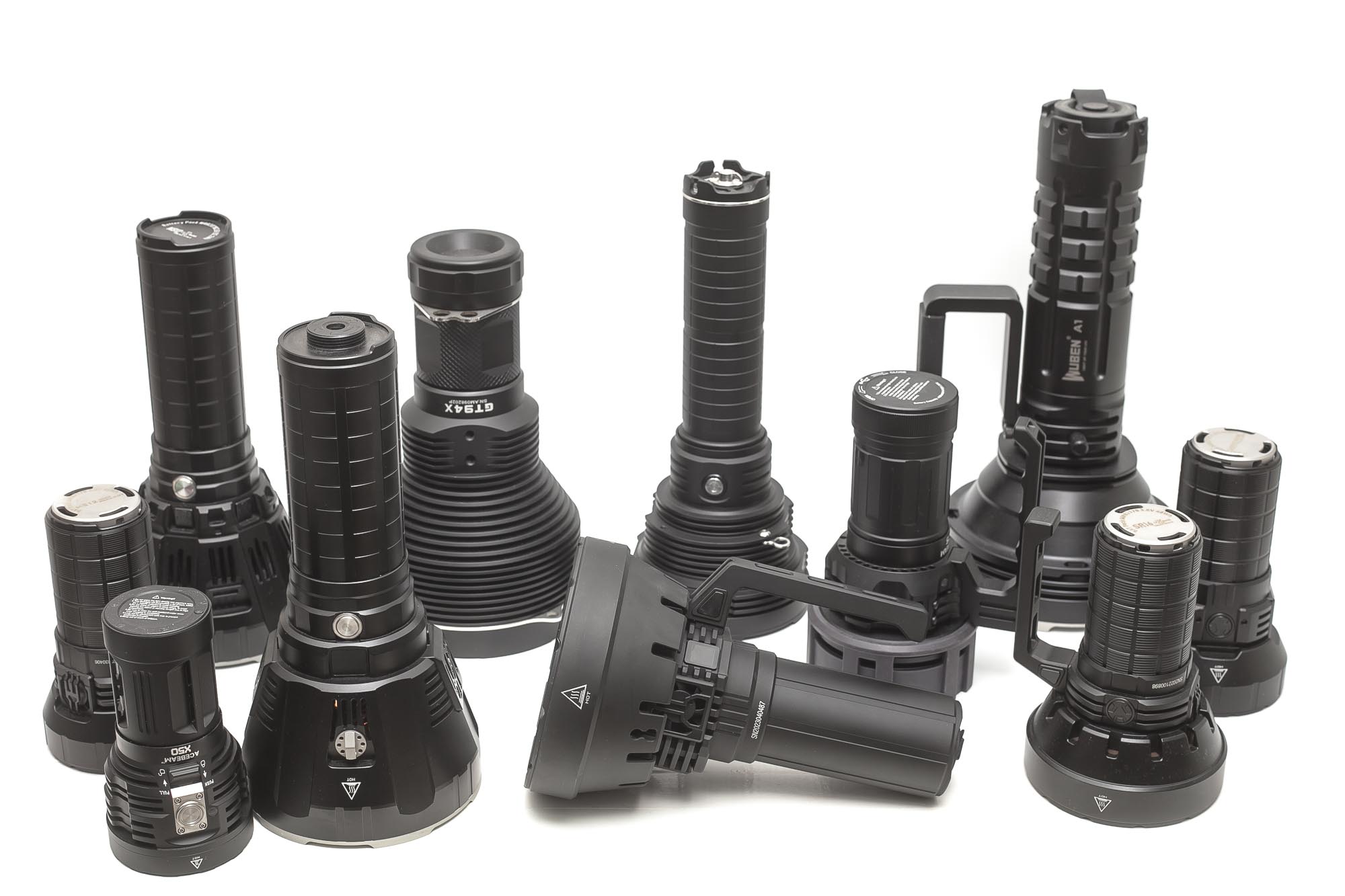
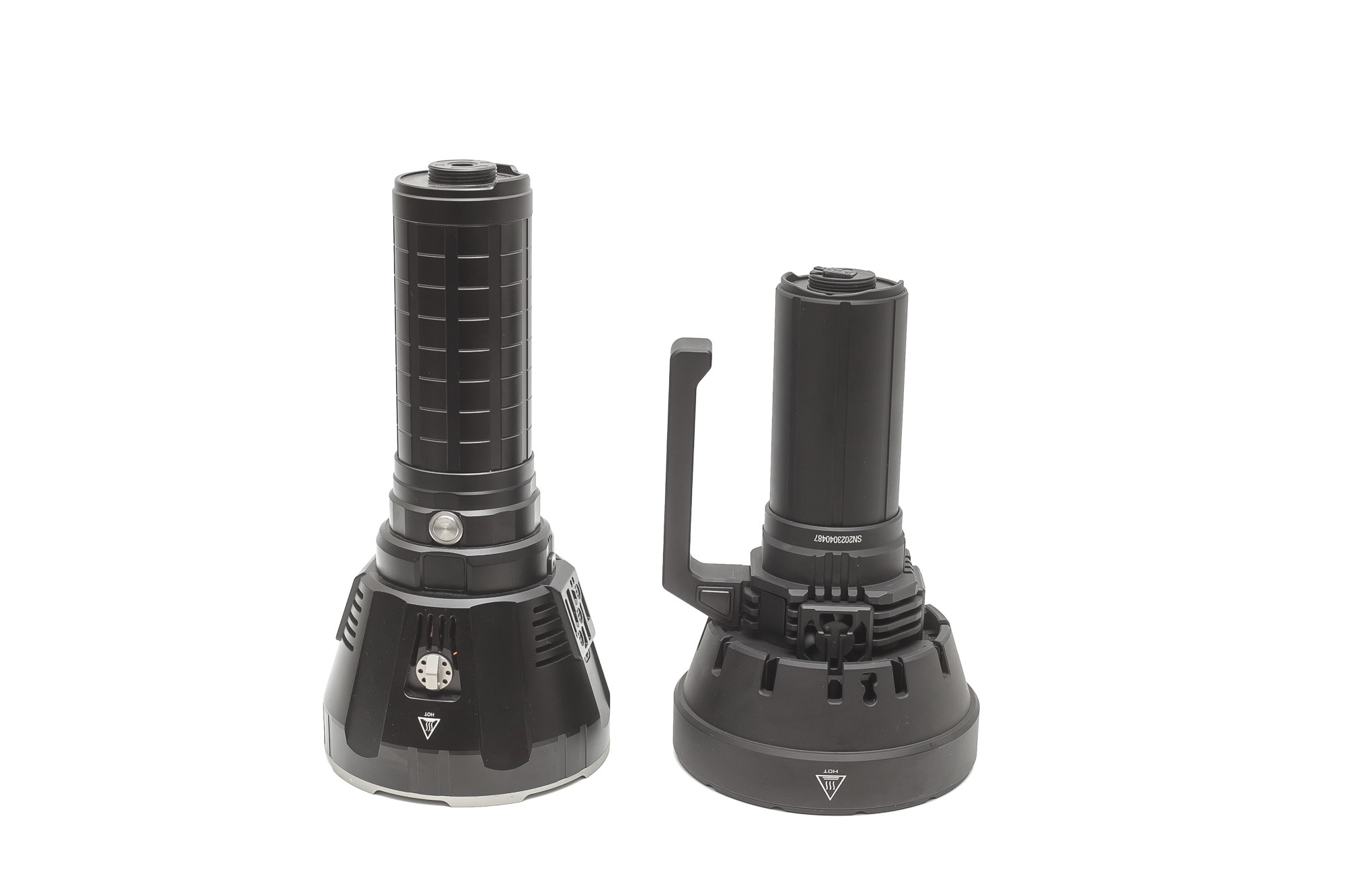
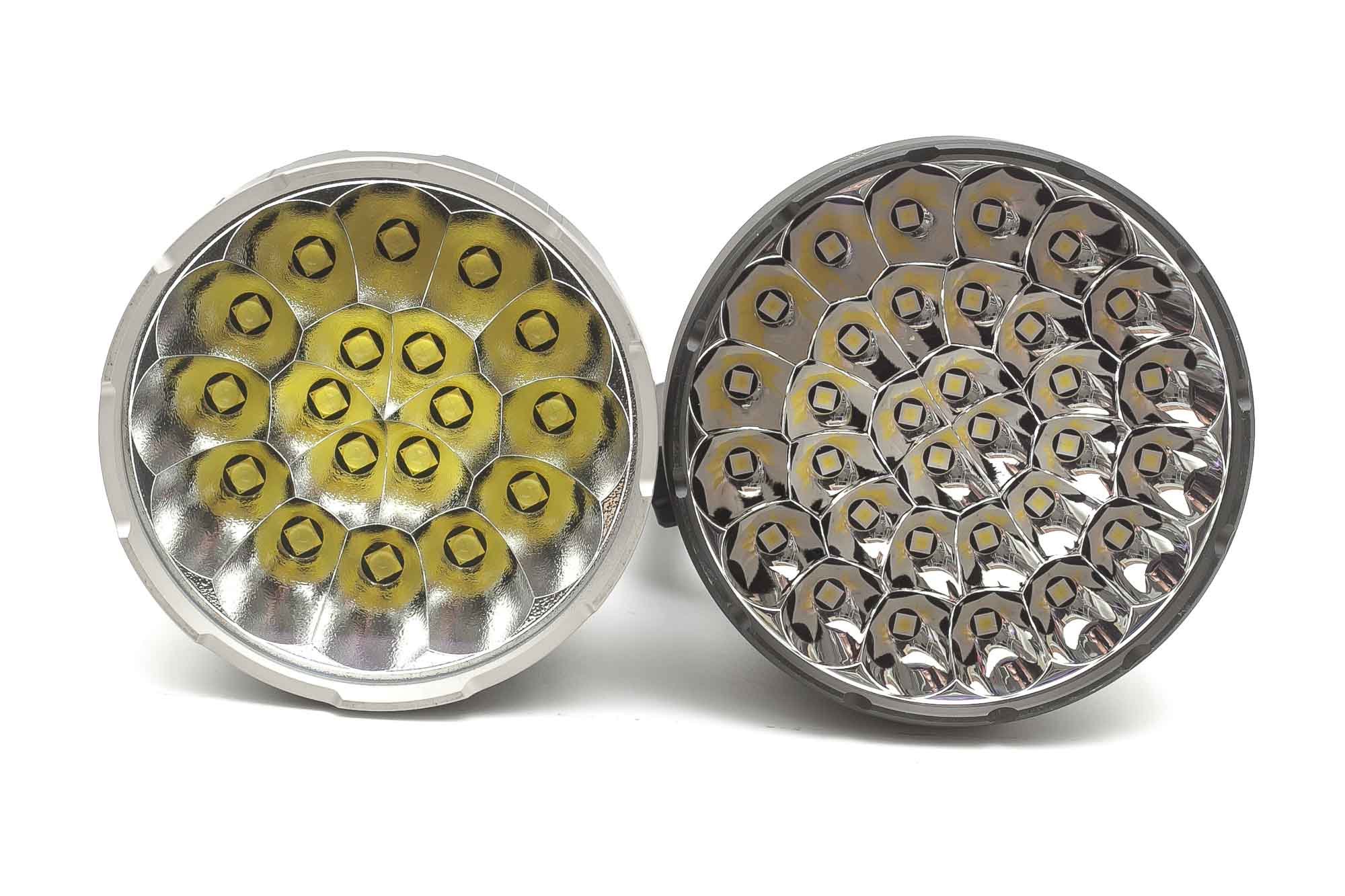
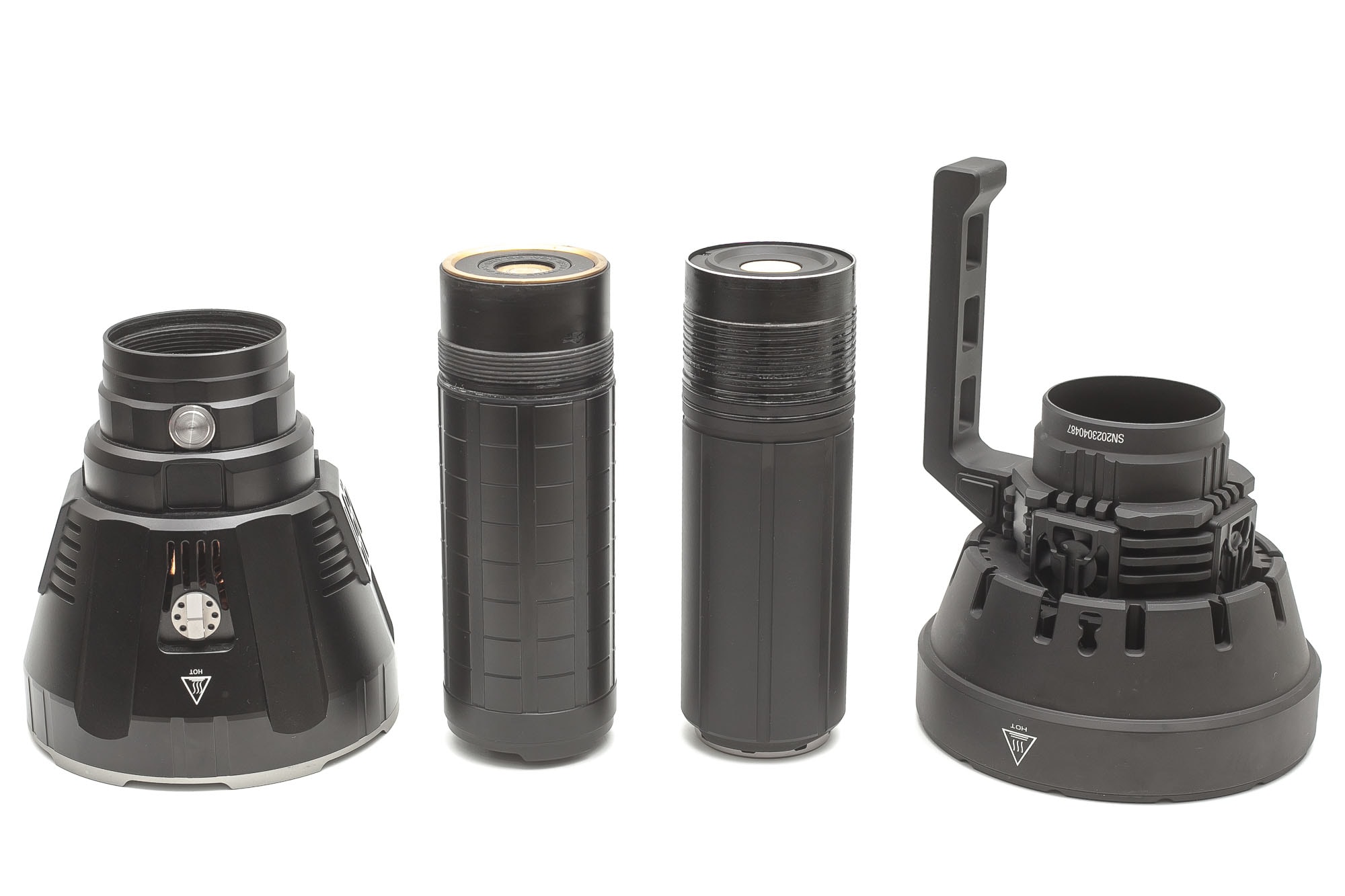
Driver & User Interface:
The SR32 has 2 switches that can be used interchangeably. There is 1 built into the body, and 1 in the handle. They both work the same, but having the one on the body, makes the light still usable when you remove the handle. Sothe UI works the same for both switches.
Available modes:
- Moonlight, Low, Middle Low, Middle 1, Middle 2, High, Turbo
From OFF: (with either switch)
- Single-click: to last used mode ( mode memory)
- Double click: Turbo (and another double click for strobe)
- 3 clicks: battery check
- 4 clicks: Lockout
- 5+ clicks: nothing
- Press and hold 3 seconds: turn on cooling fans
From ON: (with either switch)
- Single-click: off
- Double click: Turbo
- Triple-click: Battery check
- Press and hold: Cycle through the menu from Low to High
Shortcuts:
- To Turbo: double click from Off or On
- To Strobe: not available
- To Moonlight: not available
Mode memory:
- Yes (single click from off returns to last used mode)
- This is a bad idea, since there is no way to return to Moon mode, unless you run through all the other modes. Imagine you are in the 1,500 lumen mode, you have to run all the way through 50,000 lumens mode to return back to 30lm.
Blinky modes menu:
- None
Low battery warning:
- The little display shows a low battery according to the manual, but nobody will look at the little display.
Lock-out mode:
- 4+ clicks from off. Repeat 4 clicks to deactivate again. Unlike some other Imalents, you really need to click 4 times. Other Imalents would lockout with any number of clicks, more than 3..
PWM:
- Not visible
I like that Imalent included a real Low mode, and added a switch to the handle. I just don’t like the UI with mode memory, and no way to return to Moon mode without running through all the other modes. That’s a shame.
However, there is a trick to know what mode it will start in (Moon) by unscrewing the body. That way, you know that the flashlight will turn on in Moon mode. But it will only work, if you leave it unscrewed for several seconds.
Possible solutions to the UI problem:
- Like with Anduril, press and hold when on for increasing brightness, release and press and hold again for decreasing brightness
- Long press from off = moon + mode memory for Low to High
- Double click for High from off, and triple click to Turbo (we don’t see this often, but it’s a possibility)
Batteries & Charging
Imalent chose to use a built-in battery pack rather than separate cells. They also did that with the SR16, MS12, MS12 mini, and MS18. A battery pack has some benefits but also a couple drawbacks.
The battery pack is housing 8*21700 batteries with 4,000mAh each.
One of the biggest changes for Imalent is the use of USB-C charging! This was one of the features I was wishing for to include, in my previous reviews.
Et voila!
Imalent allows 100Watt fast USB-charging, to charge the battery pack within 90 minutes according to the manual. In my testing, I measured around 1 hour and 15 minutes each time, so that’s faster than claimed, nice! I also measured charging around 20Volts and 5 Amps (see the picture below).
The end voltage after charging is 16.9Volts (empty around 11.7)
They also include a 100W USB charger, with several different ports, including a 100Watt USB-C, 30 Watt USB-C, and 2* QC3.0 USB-A ports. Unfortunately, it makes some noise when in use.
I measured a total charging time of 4 hours and 18 minutes with the 30 watt USB-C option. And if you have the time to wait, I’d suggest opting for the 30 W charging option instead of 100 Watts for the longevity of the batteries.
I will remind you that charging with 100 watt is producing a lot of heat, especially on the USB charger. 100 Watts divided by 8 = about 12 watts each. Which is about 2.85 Amps per battery, so that’s actually not too bad after all.
The USB-port is located in the same position as where the DC charing port was located: at the tail end of the flashlight, underneath a rubber flap. That rubber cover doesn’t seem to be thought through too much. It’s not easy to connect the charging cable to the port one-handed. Also, when you screw back the stainless steel cover, you can feel a bit of resistance from the rubber cover. The rubber cover doesn’t get back into position very well. This was also not optimized.
Powerbank
The powerbank feature is also pretty neat. Even though the manual and website listing don’t particularly highlight this feature. I don’t know why, because it’s really useful and a great feature.
I charged my phone at almost 9V and 2Amps, which is pretty good.
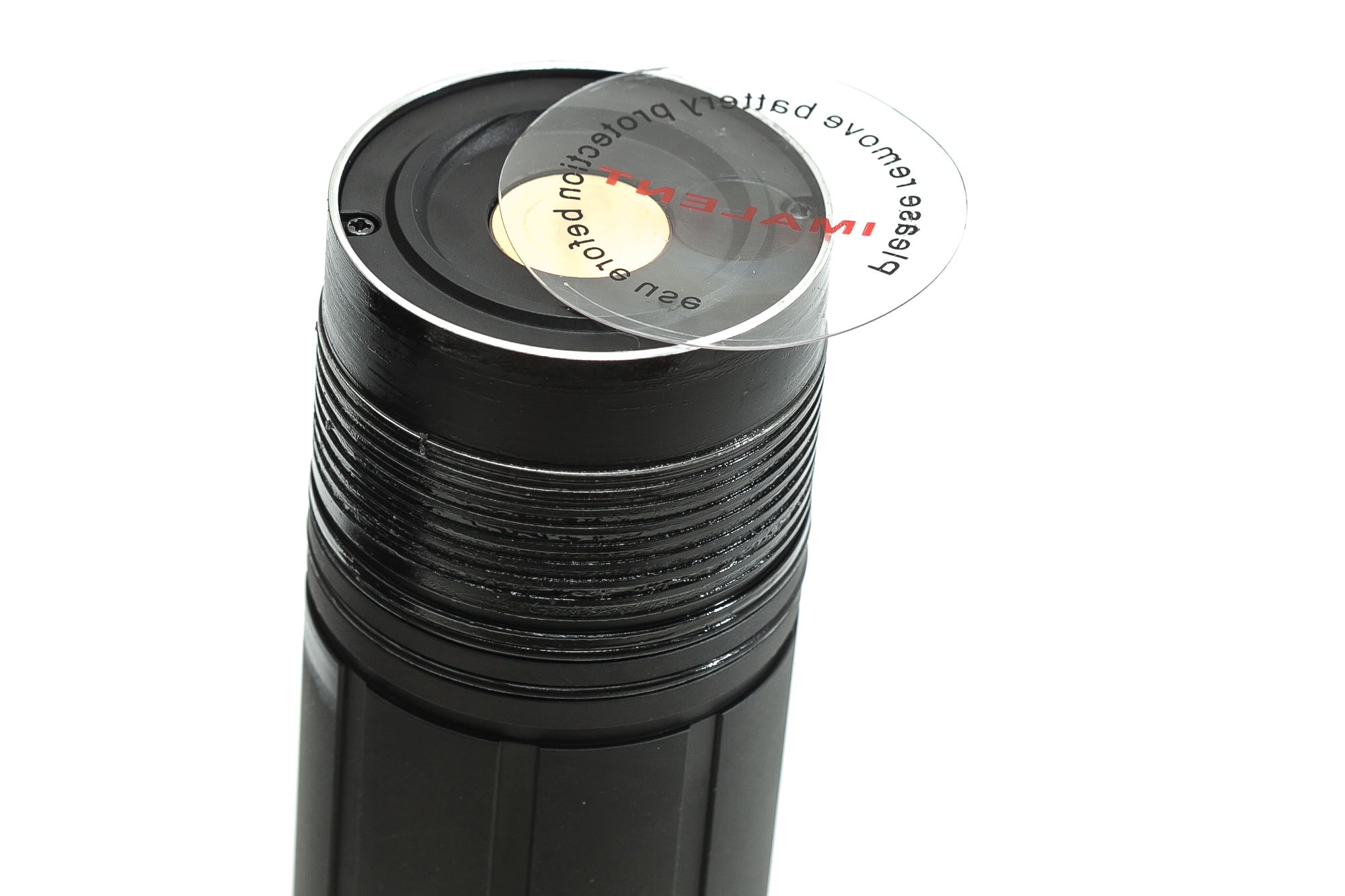
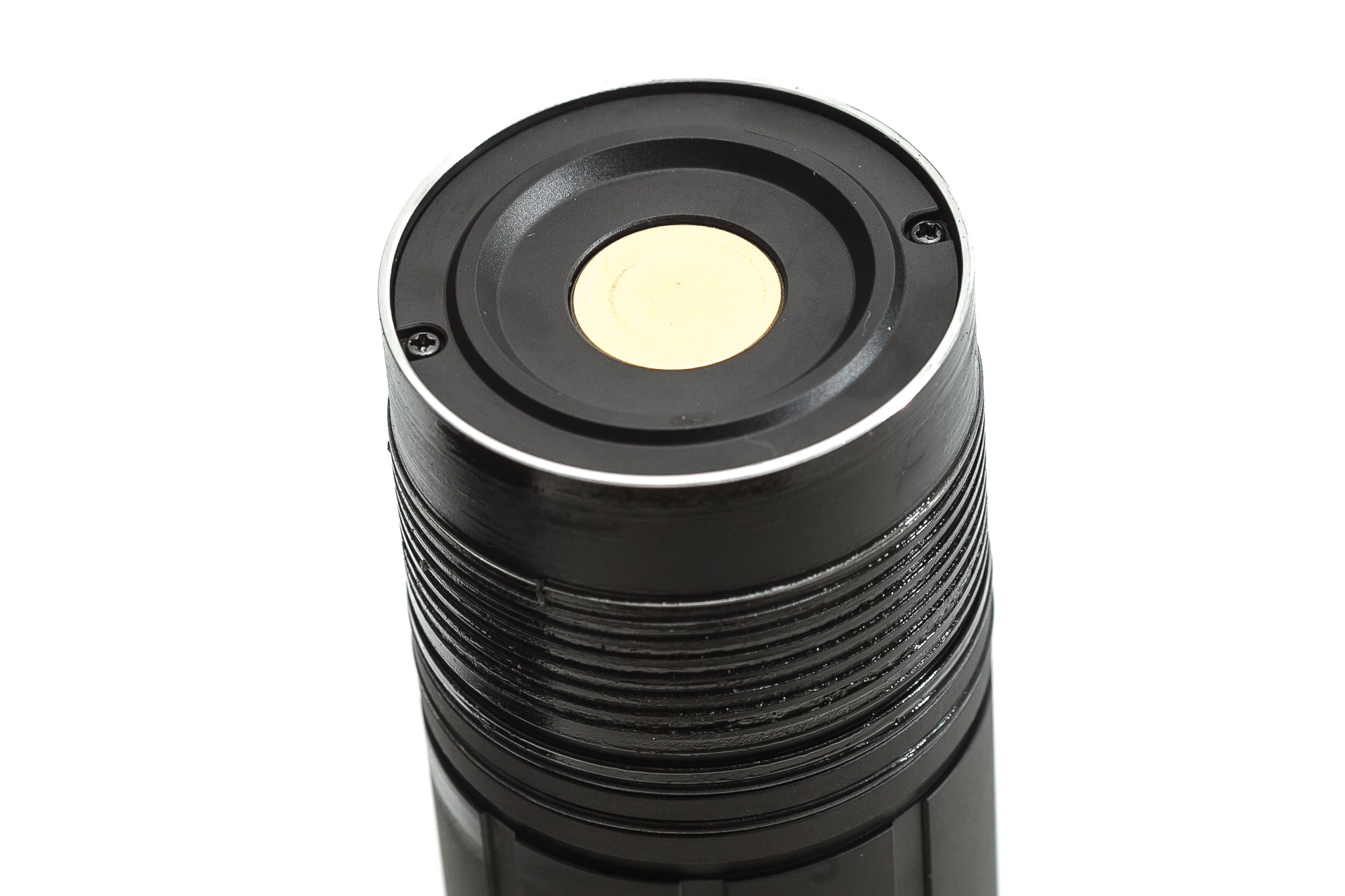
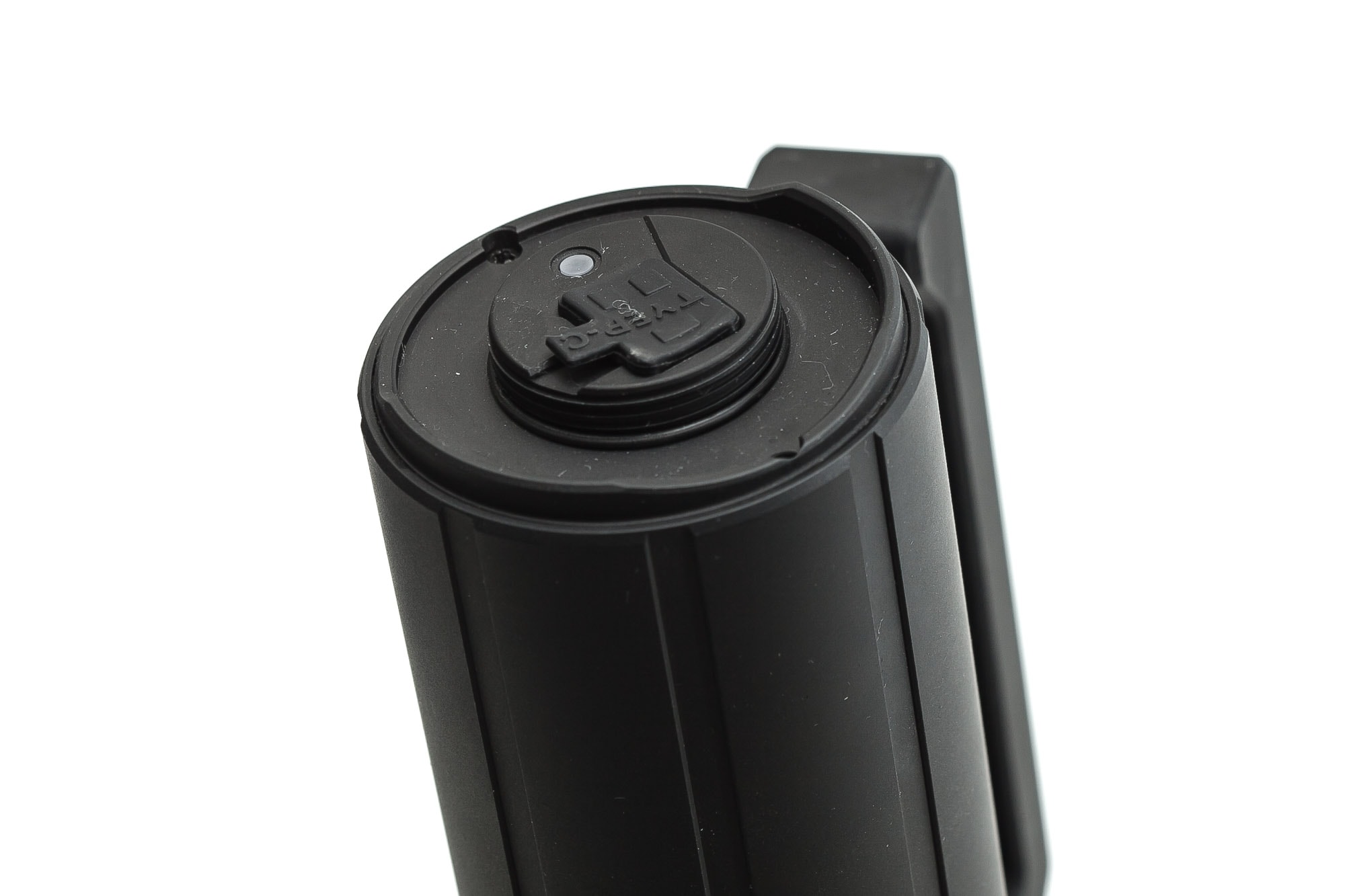
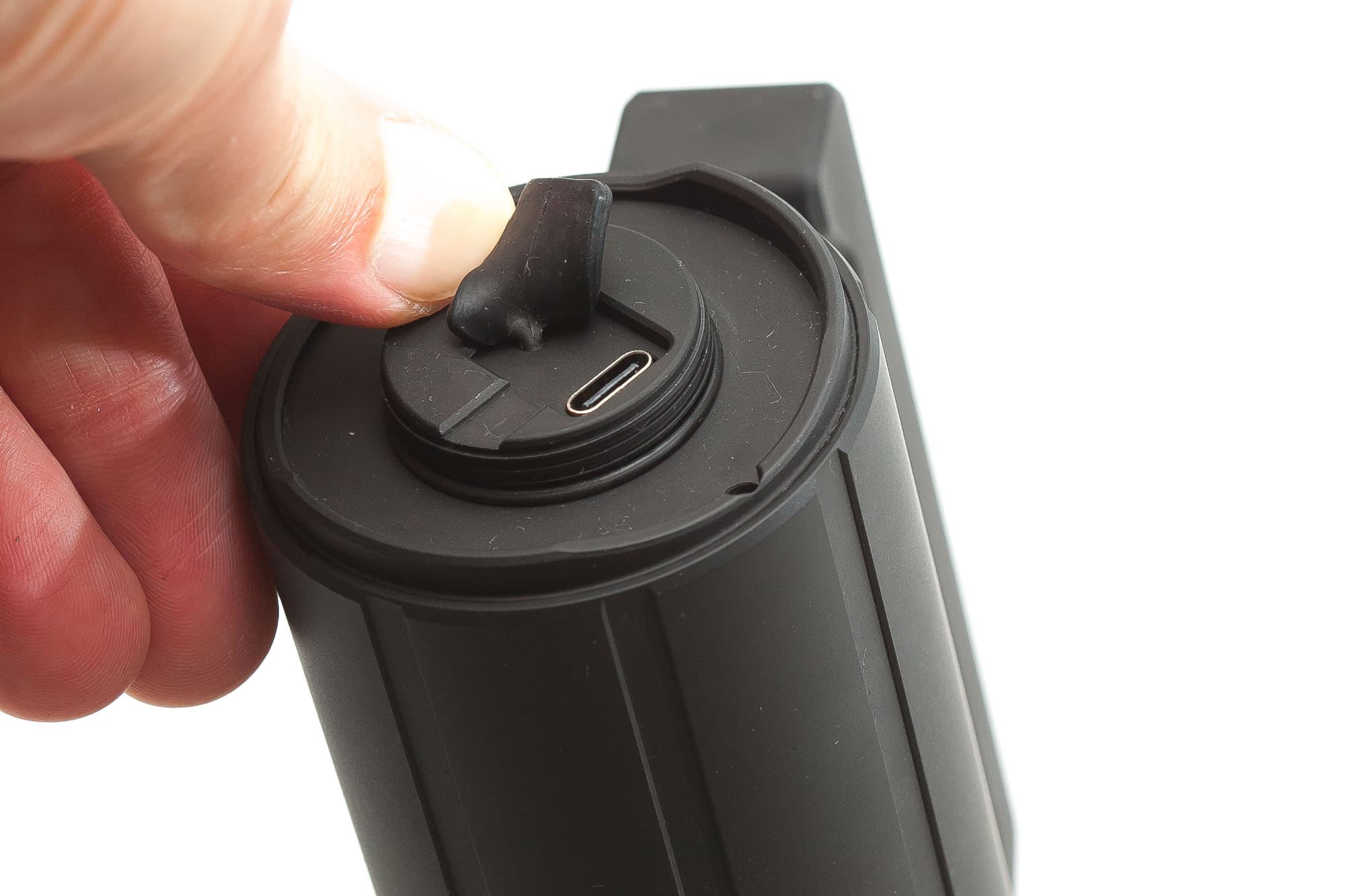
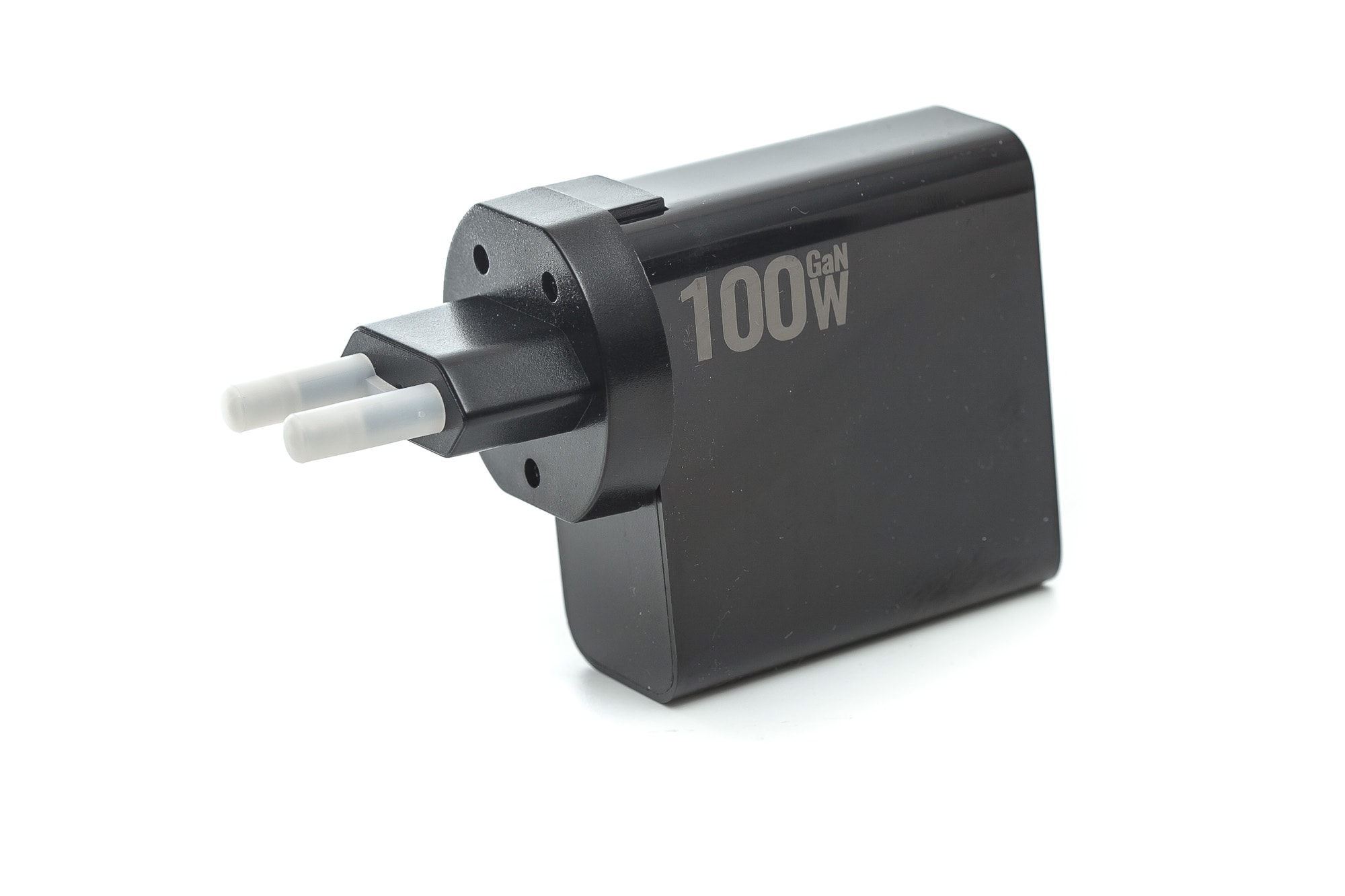
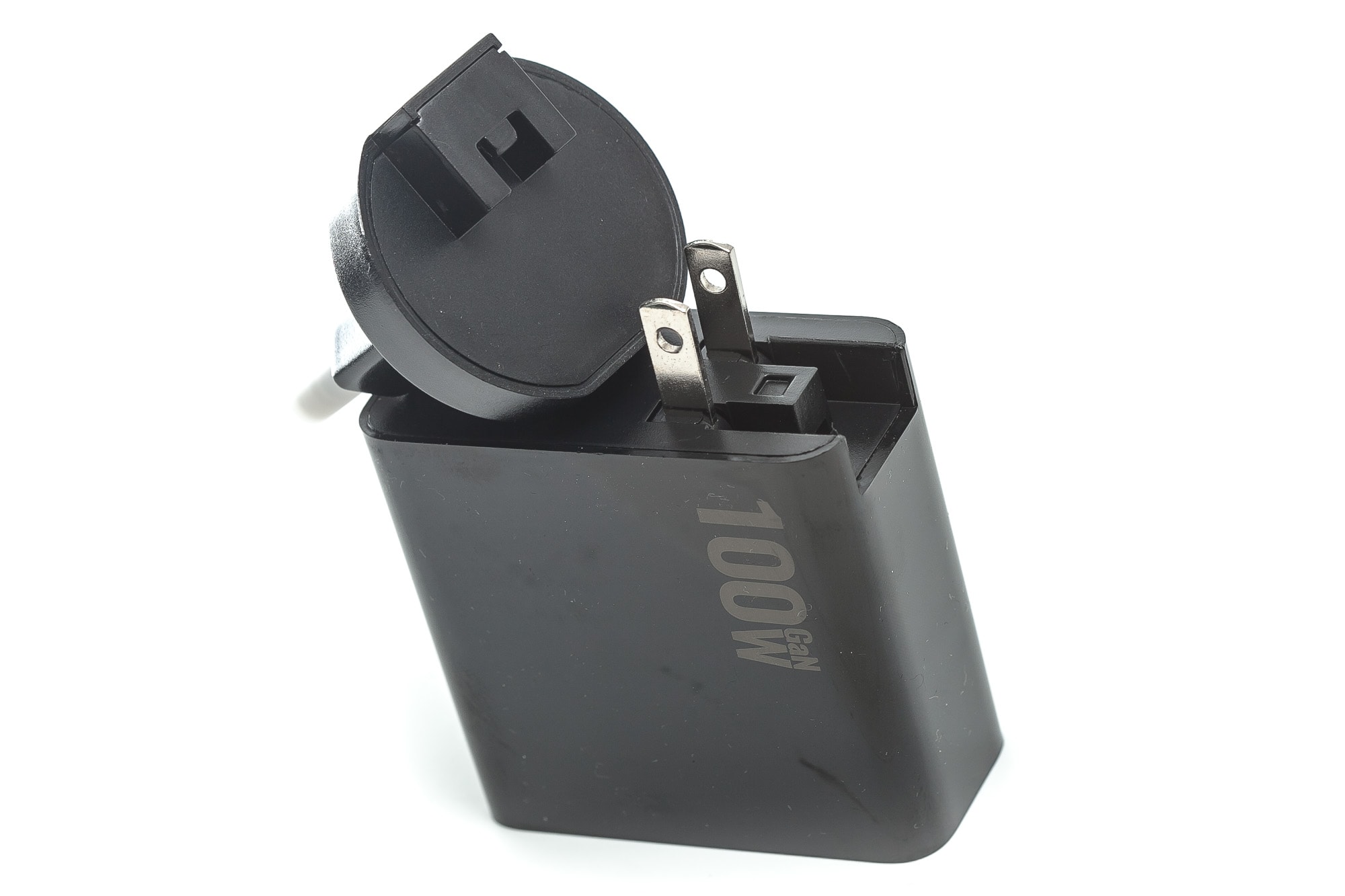

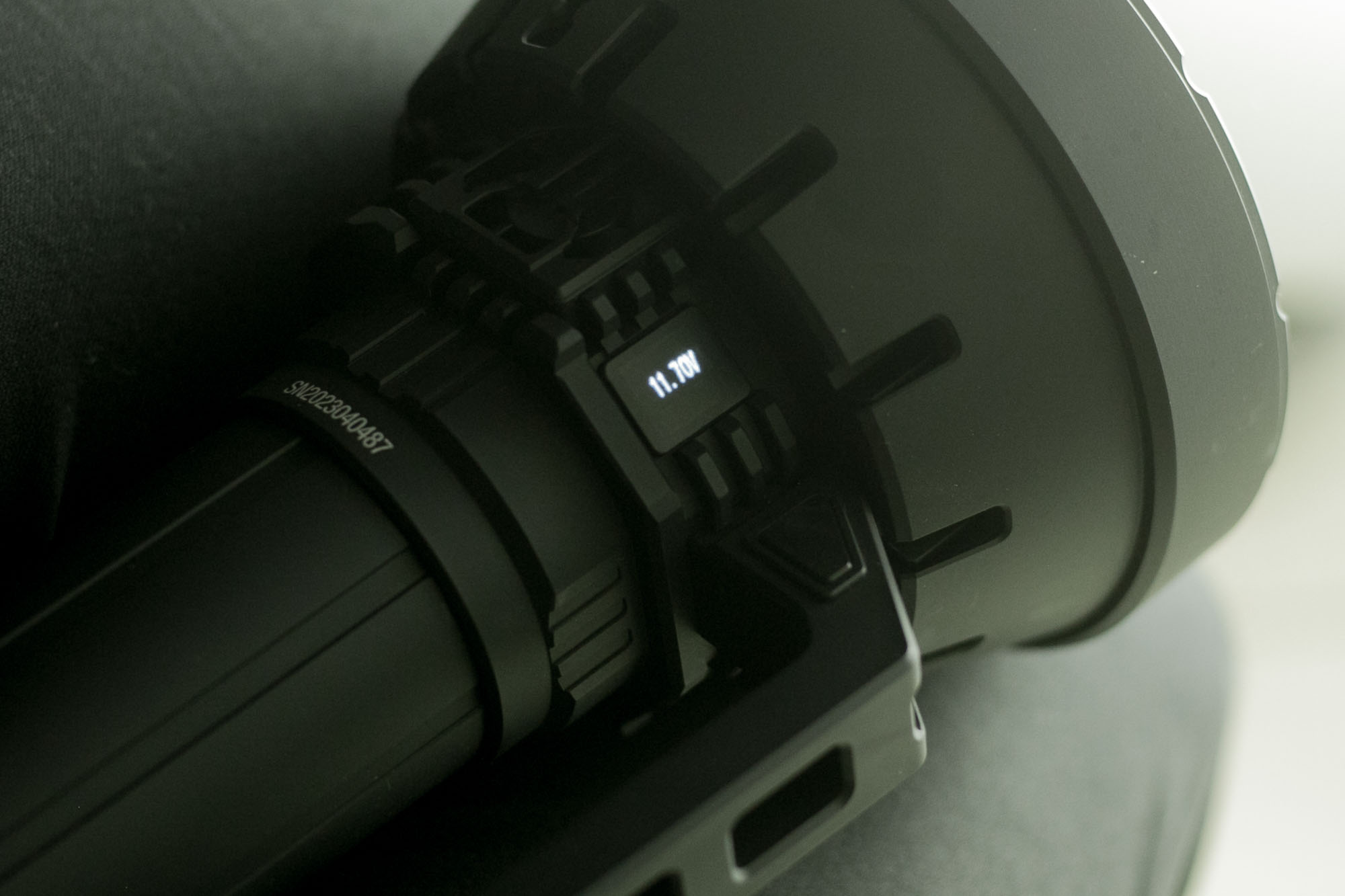
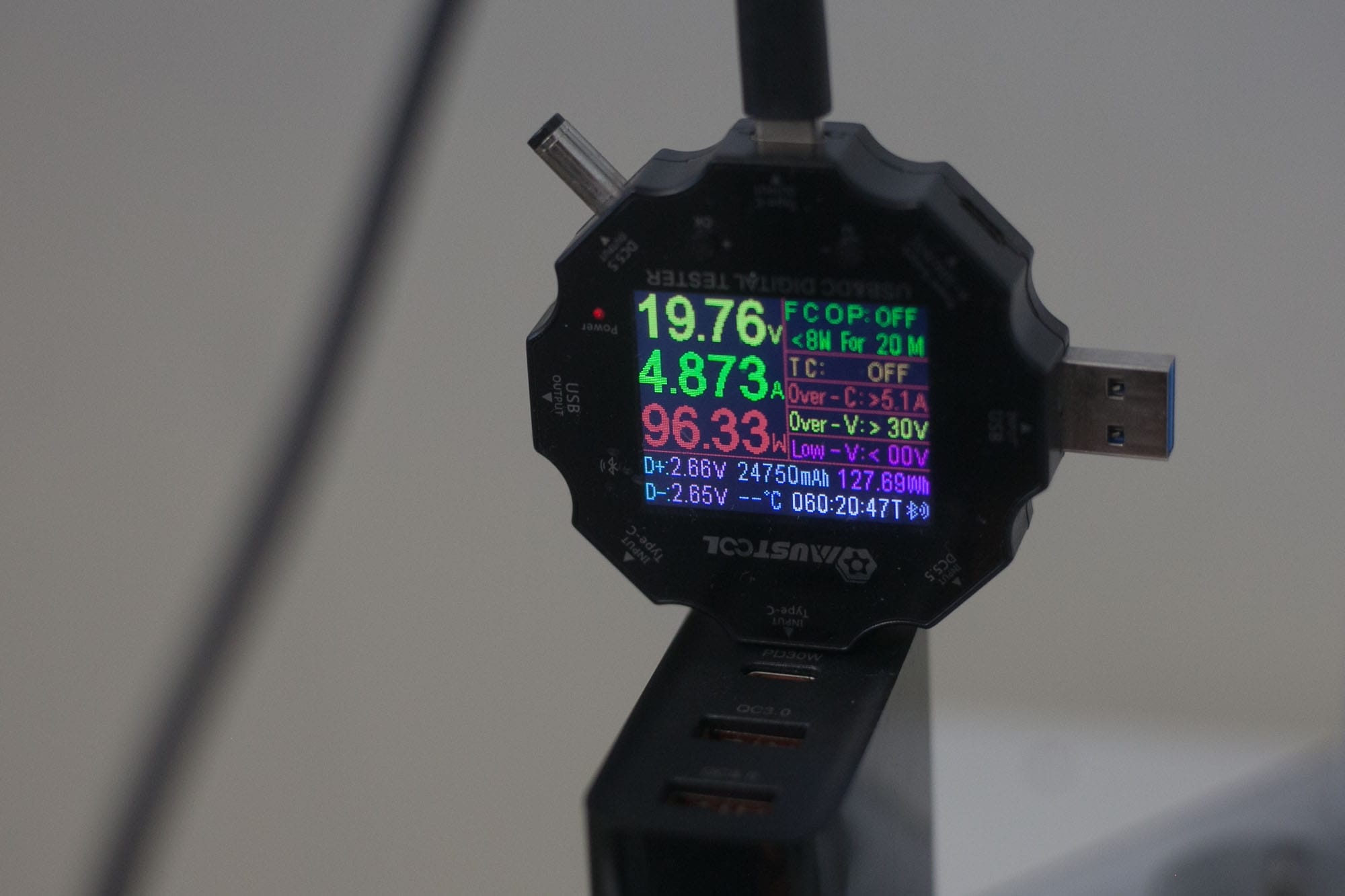
Performance test
This is the gear I use for testing:
| Gear | Purpose | Link to buy |
|---|---|---|
| Hagner E4-X | Measuring beam intensity (throw) | Inquire at Hagner.se |
| 2* Extech SDL400 | Lumens and logging runtimes | Amazon.com, Amazon.co.uk, |
| Leica Disto D2 | Distance for throw measurements | Amazon.com, Amazon.co.uk, |
| Sekonic C-800 | Spectrometer for LED measurements | Amazon.com, Amazon.co.uk |
| Uni-T UTi260B | Thermal Image camera | Amazon.com, |
Imalent SR32 Lumen measurements:
How Lumens are Measured: Understanding ANSI FL1 Standards How Lumens are Measured: Understanding ANSI FL1 Standards: The ANSI FL1 standards specify that output in lumens should be measured 30 seconds after turning on, as this is the standardized time for measuring brightness according to the industry standard. This is why we focus on this part in our measurements. The ANSI FL1 standards require an ambient temperature of 22 ± 3°C. We record the ambient the ambient temperature to identify potential reasons for any observed discrepancies.The output measurements in this review are based on my homemade integrating spheres, each equipped with an Extech SDL400 Lux Meter. For consistency and accuracy, a calibration light (Convoy S2+ with 249lm and a Convoy S2+ with 261lm) is measured prior to each set of lumen measurements.
For high-output lights, one of the lux meters uses an ND camera filter to prevent the lux meter to max out. This is either the Kenko PRO1D ND16 up till about 80,000 lumens or Gobe ND32 for anything above.
I tested all settings (except Turbo) with the ND32 as well as the ND16 filter. I also tested the lowest 2 modes without an ND filter, and interestingly enough measured right in between the 2. The room temperature during the lumen tests was about 22-23 degrees celsius.
All of my readings were taken from a fully-charged battery pack, except for the lowest 3 modes.
The measurements were taken manually at turn on and 30 seconds. The 10-minute numbers are taken from the runtime graph.
I tested the highest output several times, to make sure I didn’t accidentally miss anything.
This table is updated with the newest SR32 I got, with improved performance.
| Mode | Specified | at turn on | 30 sec | 10 minutes |
|---|---|---|---|---|
| Moon | 30 lm | 43 lm | 43 lm | – |
| Low | 1,500 lm | 1,898 lm | 1,896 lm | 1,849 lm |
| Mid Low | 4,500 lm | 5,044 lm | 5,023 lm | 4,733 lm |
| Mid 1 | 9,000 lm | 8,917 lm | 8,981 lm | 8,953 lm |
| Mid 2 | 25,000 lm | 16,962 lm | 17,281 lm | 17,501 lm |
| High | 50,000 lm | 26,488 lm | 54,737 lm | 16,978 lm |
| 68,260 lm (60sec) | 25,544 (90sec) | |||
| Turbo | 120,000 lm | 101,532 lm | 91,014 lm | 17,960 lm |
| 53,234 lm (60 sec) | 17,065 lm (90sec) |
The newest SR32 I got performed way better. High mode started low at 26000 lumens, but increased to over 50,000 lumens after 30 seconds. At 60 seconds, High mode was over 68000 lumens. Even though this behavior is pretty strange, it does meet the ANSI FL1 standards output at 30 seconds.
Turbo mode also improved over the previous SR32 I got. The newer one can sustain almost 90,000 lumens for 50 seconds, when it starts dropping. This is much, much better than the previous one.
I didn’t test the runtime test in Moon mode, as it is supposed to run for 360 hours. I have too many modes and flashlights to test, so I usually keep them within 24 hours. When I have time, I sometimes let it run for 2-3 days, but that doesn’t happen too often.
You can see that I didn’t reach close to the specced 120,000 lumens. And yes, I tested it with the first and second SR32 I got. I also tested the MS18 again just to make sure.
Mid1 and Mid2 are also interesting, as they start out lower and increase output towards the 30-second mark.
Imalent SR32 battery life and runtime graphs
How Runtimes are Measured: Understanding ANSI FL1 Standards About ANSI FL1 runtime standards: The runtime is measured until the light drops to 10% of its initial output (30 seconds after turning on). This does not mean that the flashlight is not usable anymore. The last column shows how long the light actually works till it shuts off. If there is a + symbol, it means that the test was stopped at that particular point, but the light was actually still running. This happens on certain occasions, with certain drivers, firmware, or batteries.The runtime test was done with the 50cm integrating sphere, with camera ND16 filter for the lower modes, and ND32 for Turbo. I logged the output every 5 seconds with the Extech SDL400 lux meter.
| Mode | Specified | Measured runtime (ANSI FL1) | Time till shut off |
|---|---|---|---|
| Moon | 360h | – | – |
| Low | 15h | 15h 41min | 15h 41min |
| Mid Low | 4h 25min | 4h 41min | 4h 41min |
| Mid 1 | 2h | 2h 07min | 2h 07min |
| Mid 2 | 55min | 53min | 53min |
| High | 60sec+ 50min | 49min 55sec | 49min 55sec |
| Turbo* | 40sec+ 45min | 41min 35sec | 41min 35sec |
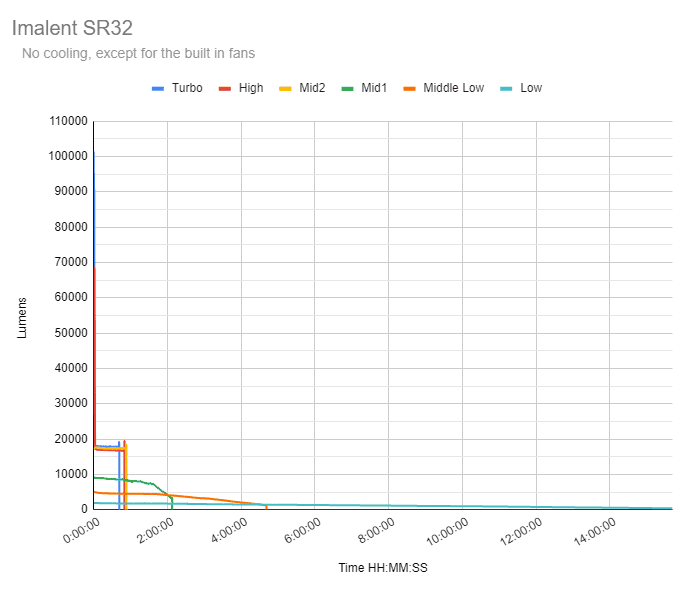
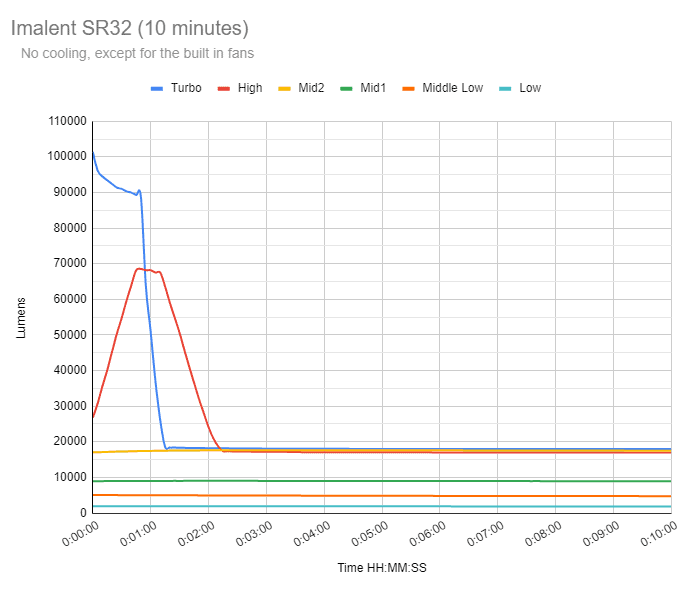
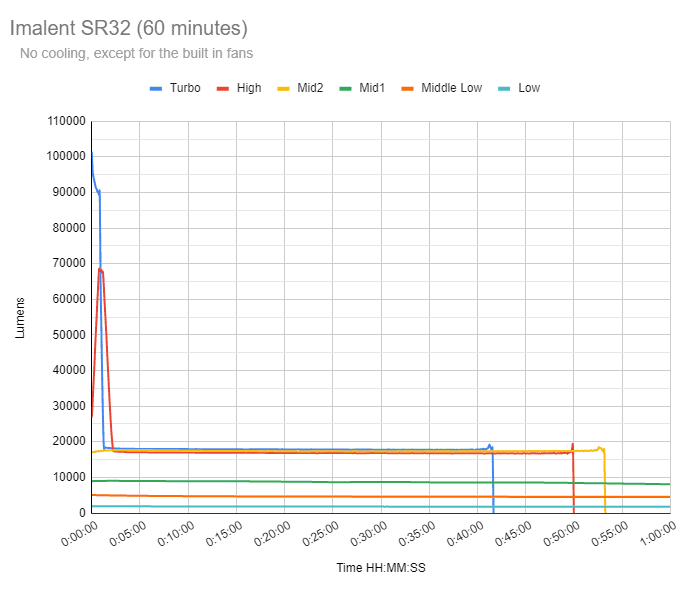
My runtime measurements were pretty close to the advertised numbers. I measured around 11.7V after the 9,000 lm runtime.
During the runtime, I also measured the temperature with a Thermal Image camera.
The MS18 can overheat in the 10,000 lumen mode, because the fans wouldn’t turn on. I did some extra testing with Mid1 mode (9,000 output) on the SR32, and the temperature was kept in check. I measured roughly around 5, 10 and 15 minutes.
I also added 2 measurements in High mode (of my earlier SR32 sample), at 30 minutes and 60 minutes, and those temperatures were also kept low.
Then 1 more image for Turbo mode after about 40 minutes.
Without fans, the flashlight would have been extremely extremely hot around this point. But the fans really do their work.
Here are the thermal images:
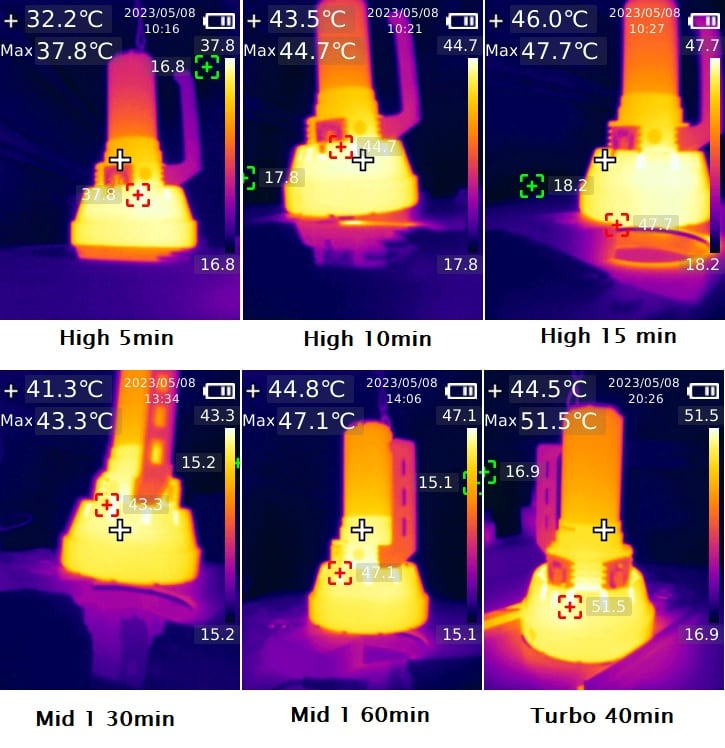
Imalent SR32 Peak beam intensity and beam distance measurements
About Peak beam intensity: Understanding ANSI FL1 Standards About peak beam intensity The calculated value of distance in meters at which the flashlight produces a light intensity of 0.25 lux. (0.25 lux is about the brightness of a full moon shining on an object). This means that the intensity has decreased so much, it becomes difficult to see darker objects, or objects that don’t reflect light. The columns ‘Meters’ and ‘Yards’ use rounded numbers.Measurements below are taken indoors at 5 meters with a Hagner E4-X Lux Meter. Measurements were taken 30 seconds after turn on. I also tested Mid2 at 20 meters outdoors, because it was the most stable output of the higher modes, and got a little lower numbers. So the following numbers are still on the upper side of the measurements.
This table is updated with the new SR32.
| Mode | Specs | Measured Cd | Meters | Yards | Miles |
|---|---|---|---|---|---|
| Moon | – | 350 cd | 37 | 41 | 0.02 |
| Low | – | 15,850 cd | 252 | 275 | 0.16 |
| Middle Low | – | 43,000 cd | 415 | 454 | 0.26 |
| Mid 1 | – | 80,750 cd | 568 | 622 | 0.35 |
| Mid 2 | – | 155,000 cd | 787 | 861 | 0.49 |
| High | – | 472,500 cd | 1375 | 1503 | 0.85 |
| Turbo | 1,090,000 (2080m) | 777,500 cd | 1764 m | 1929 yd | 1.1 mi |
Turbo was tested with my lux meter set to 100*, which makes the lux meter’s numbers a bit less sensitive. The new SR32 I received performed much better than the previous one.
High mode also performed much better, but after 30 secons it wasn’t even at its peak. The peak is around 50-55 seconds, so keep that in mind.
Before I tested throw, I already ‘expected’ it wasn’t going to reach the specified distance or intensity. Especially according the ANSI FL1 standards, which is measured after 30 seconds. My 2nd copy is still not reaching the specified 2080 meters, but 1764 meters isn’t bad!
It’s still amazing to see the beam reach almost 800 meters in Mid2 and above sustained. The lumen output and beam distance are still incredible.
See the following graph where the highest output lights are compared!
The dark lines are Turbo and High mode of Imalent SR32… pretty, pretty good!
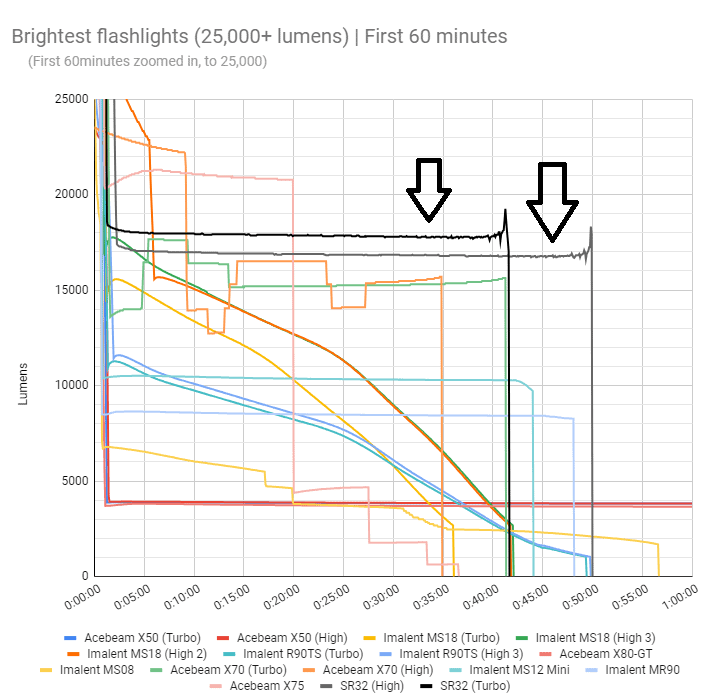
Imalent SR32 vs MS18
As you may know, the current record holder as the brightest flashlight in the world, is the Imalent MS18. And since we tested them both, here are some comparison graphs
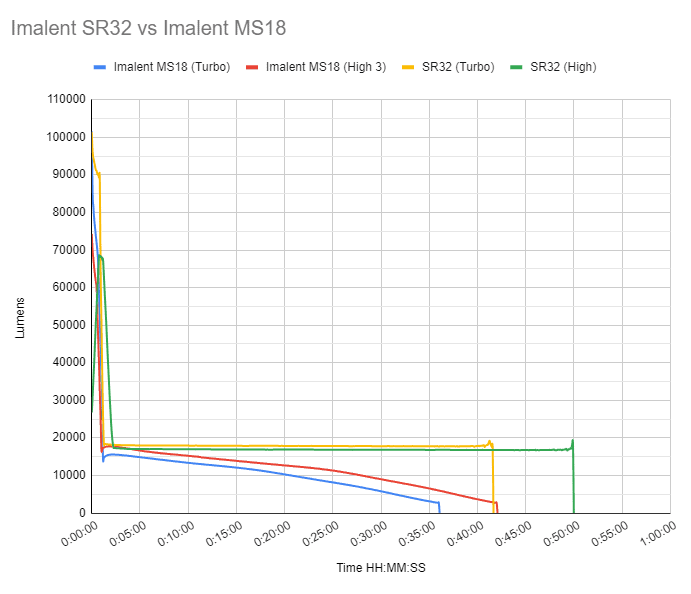
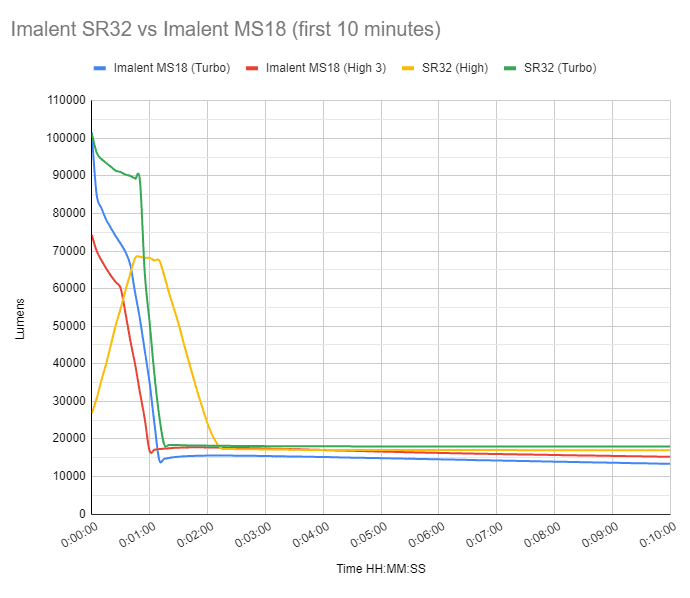
From this graph you can see the following:
- The SR32 sustains Turbo for almost a minute before dropping. It drops much slower than the MS18 in Turbo.
- The SR32 High mode increases brightness for almost 1 minute, hangs in there, and then reduces output
- The SR32 has a better sustained output, and longer runtimes. The MS18 reduces output overtime, while the SR32 stays pretty consistent.
- What’s not in this grahp is the throw. I had to retest the MS18 for this, because it wasn’t clear whether I tested it at 30 seconds or not. This added another 1-2 hours on top of the SR32 review (the battery needs to recharge between each mode testing). But the SR32 throws much better and farther.
- In terms of peak output, it’s almost a draw, with a slight edge to the SR32.
Which one would you buy? The MS18 or SR32
If you’d ask me for advise, I’d get the SR32 for the following reasons:
- Better sustained output
- Better mode spacing (the modes on the MS18 all look very similar), even though 50K output is strange
- Better throw / beam intensity (from 60 seconds onward, you still get 150,000 cd with the SR32 vs 65,000 cd with the MS18. And the MS18 will only decrease further over time.
- USB-C charging (faster)
- Powerbank feature (this is a great feature)
- Newer, so spare parts are easier to get, in case it breaks
- 2 switches (one in the handle, and 1 in the body)
- Because of the carry handle for easy carry.
Imalent SR32 vs Acebeam X75 vs MS18
Per request.. here is another comparison, but then with the 3 most powerful, including the second highest modes.
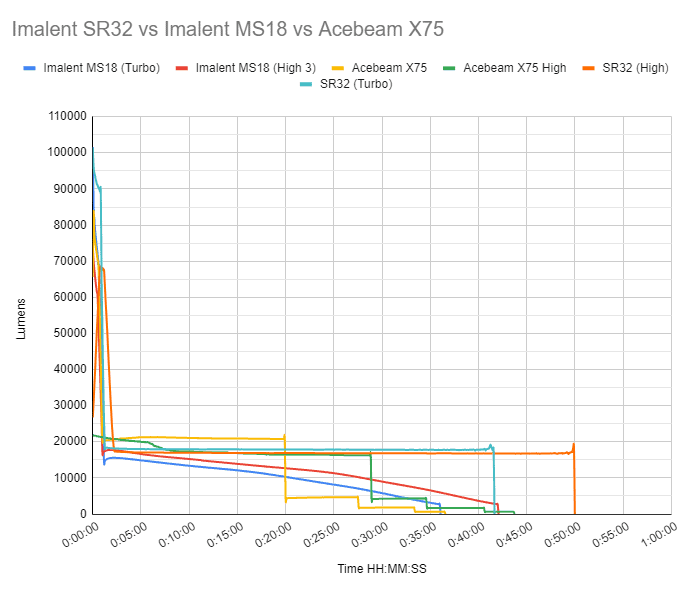
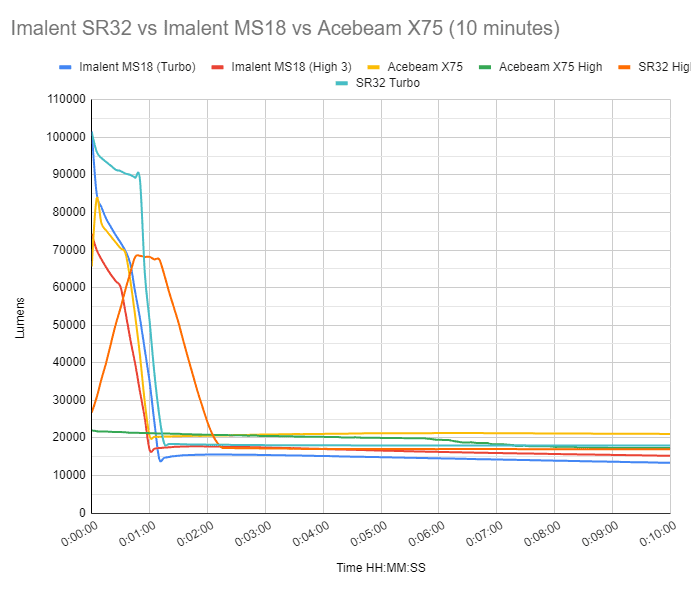
Compared to other powerful flashlights
Below is a list of the brightest flashlights we have reviewed with an output of over 50,000 lumens.
The following list contains our own measurements and not the manufacturer’s specs. The maximum output is usually measured at turn on, but sometimes after a couple of seconds. The 30-second measurement is according to ANSI FL1 standards, and the 10-minute measurement indicates its sustained output. Discontinued flashlights will be removed from the list.
| Flashlight | Max. Output | 30 sec | 10 minutes |
|---|---|---|---|
| Acebeam X75 | 83,607 | 73,716 | 21,061 |
| Haikelite HK08 | 64,447 | 59,727 | 3,985 |
| Imalent MR90 | 52,326 | 32,128 | 8,574 |
| Imalent MS08 | 25,745 | 19,615 | 6,049 |
| Imalent MS12 Mini | 68,773 | 46,750 | 10,454 |
| Imalent MS18 | 101,626 | 69,879 | 13,365 |
| Imalent MS32 | 179,678 | 166,133 | 37,396 |
| Imalent SR16 | 53,657 | 43,115 | 8,956 |
| Imalent SR32 | 101,532 | 91,014 | 17,960 |
| Flashlight name | Lumens | Lumens | Lumens |
Hover your mouse over any particular line in the following graphs to see data points! Or select a flashlight at the bottom of the graph to highlight that particular graph.
Are you on a mobile phone? Hold your phone horizontally.
(Interactive graphs)
Full runtimes:
Or check this link to view the full interactive chart.
Zoomed in for the first 10 minutes
Or check this link to view the 10 minutes interactive chart.
Beamshots
A week before I did these beamshots I went for a walk on a dyke (we have lots of those, here in the Netherlands) which really showed its potential. A treeline a couple of hundred meters away, behind some fields, was lit very brightly.
For the following beamshots, I used a Canon EOS 5D Mk2 with a 50mm lens. Manual settings: ISO1600, 1/4sec, F4, 5000K
The shed is about 65 meters / 71 yards away, and the reflective fence is about 200 meters.
These following flashlights are compared:
- Imalent SR32
- Acebeam X75
- Imalent MS18
- Imalent MR90
- Imalent SR16
- Imalent MS12 Mini
The first set of pictures are white washed.. just like you would see in person. I know this is not the best comparison, so the next set will show some longer-distance shots (200 meters). Hopefully, they will do a bit more justice. At least you should be able to see that it’s also a good thrower.
Lol.. the following pictures show that the current camera setting is mainly good for up to about 50K lumens. But you get the point. Beyond that, 65 meters distance is not far enough to compare these monsters.
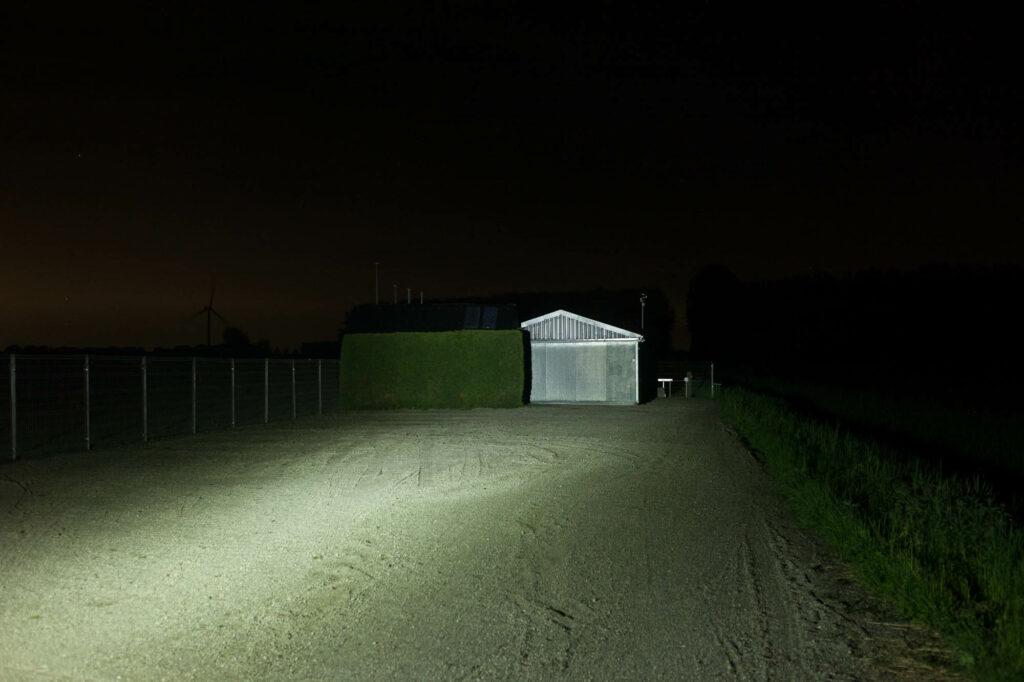
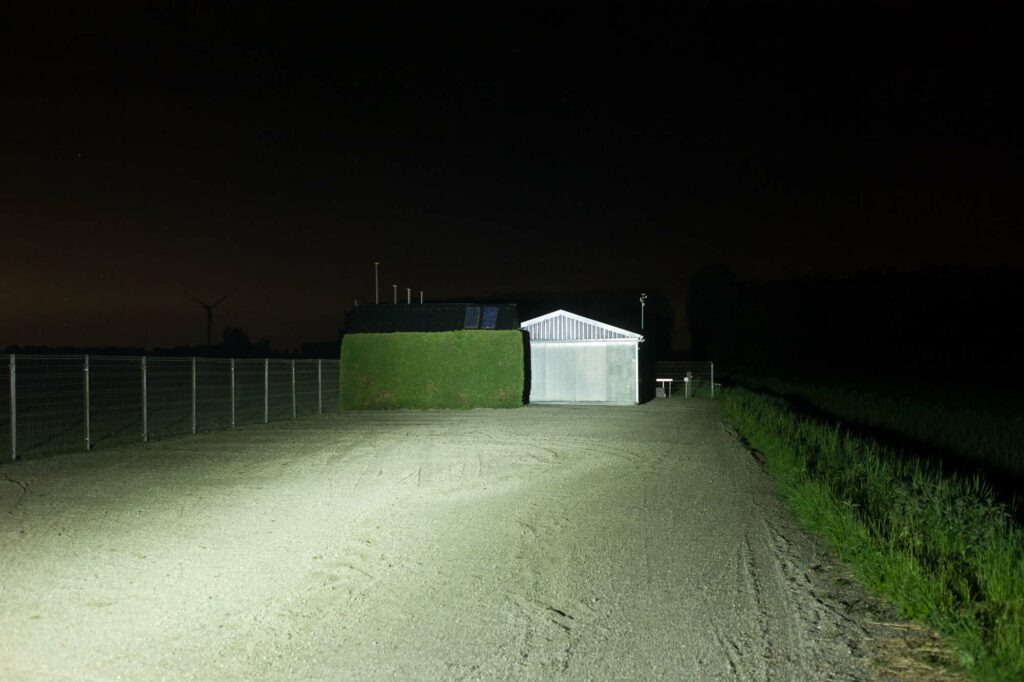
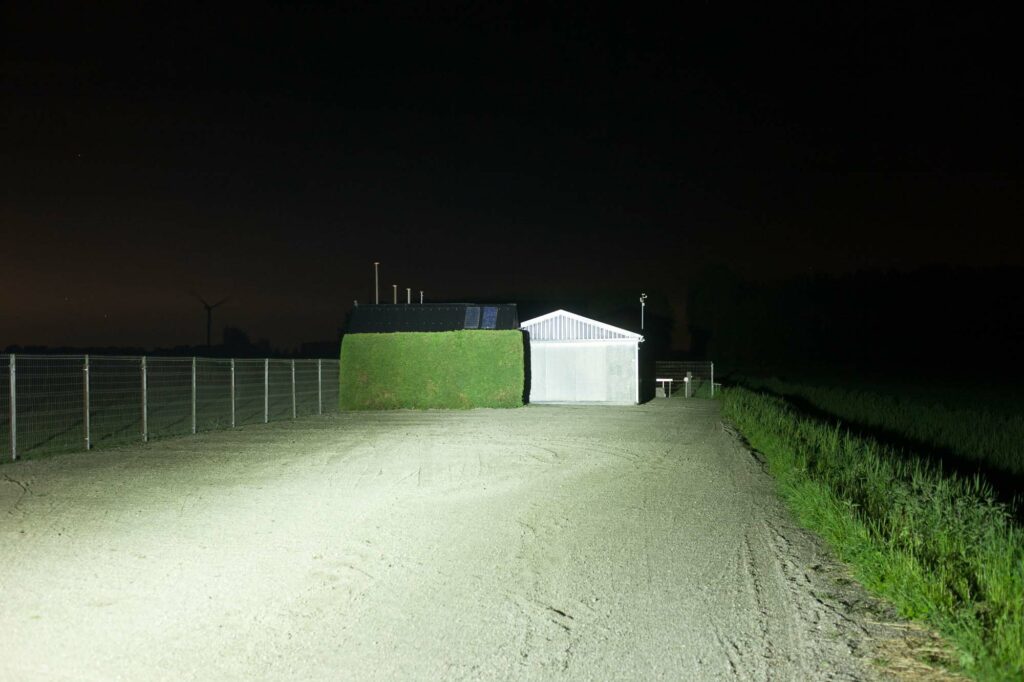
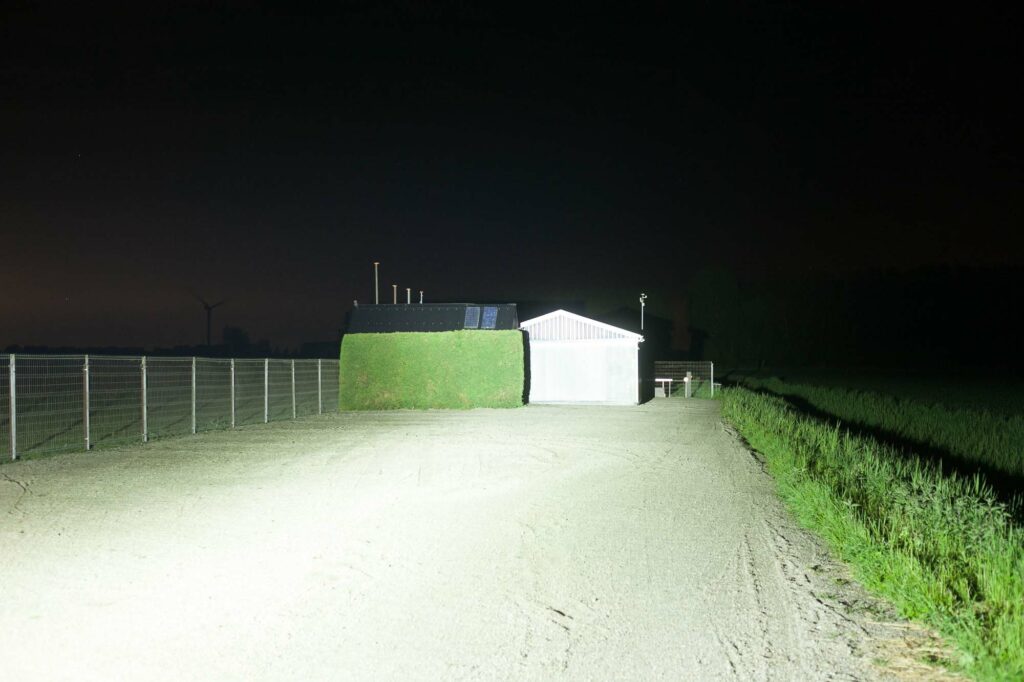
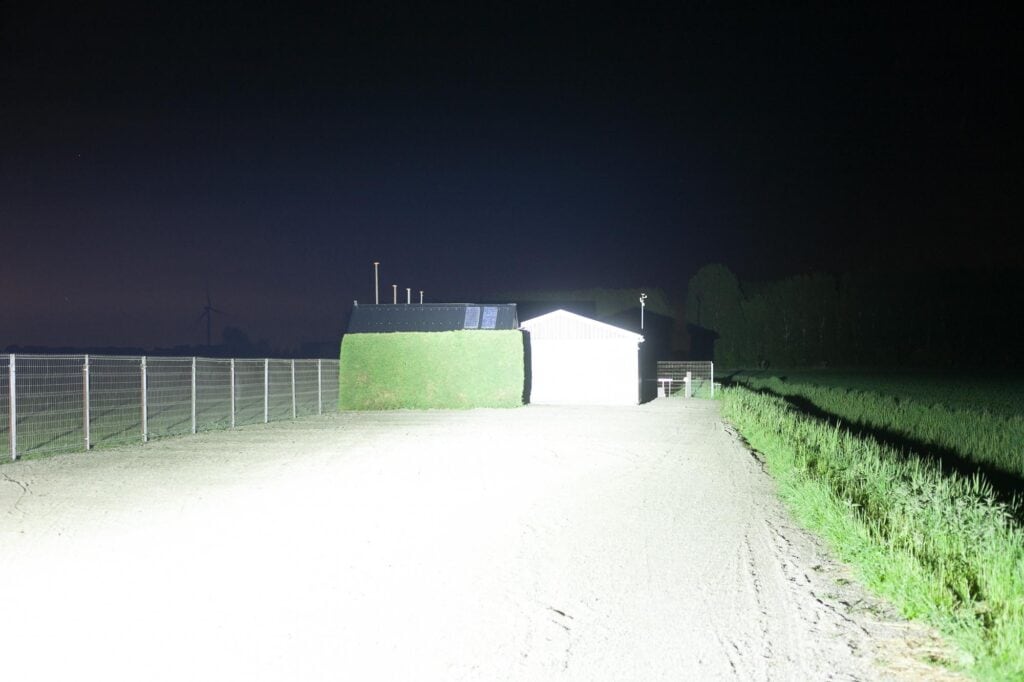
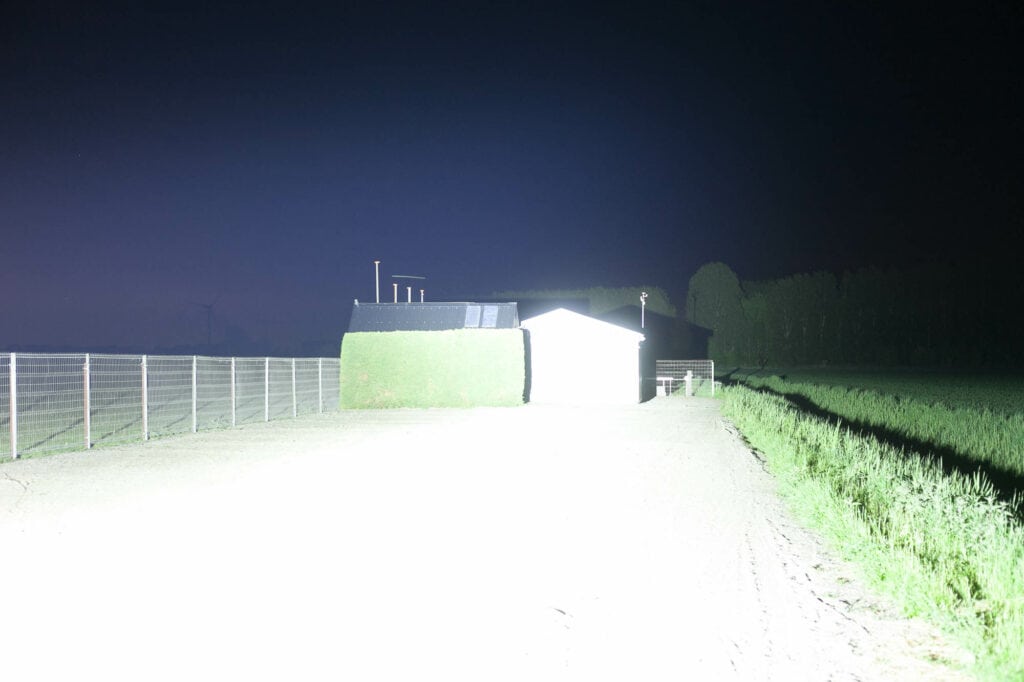
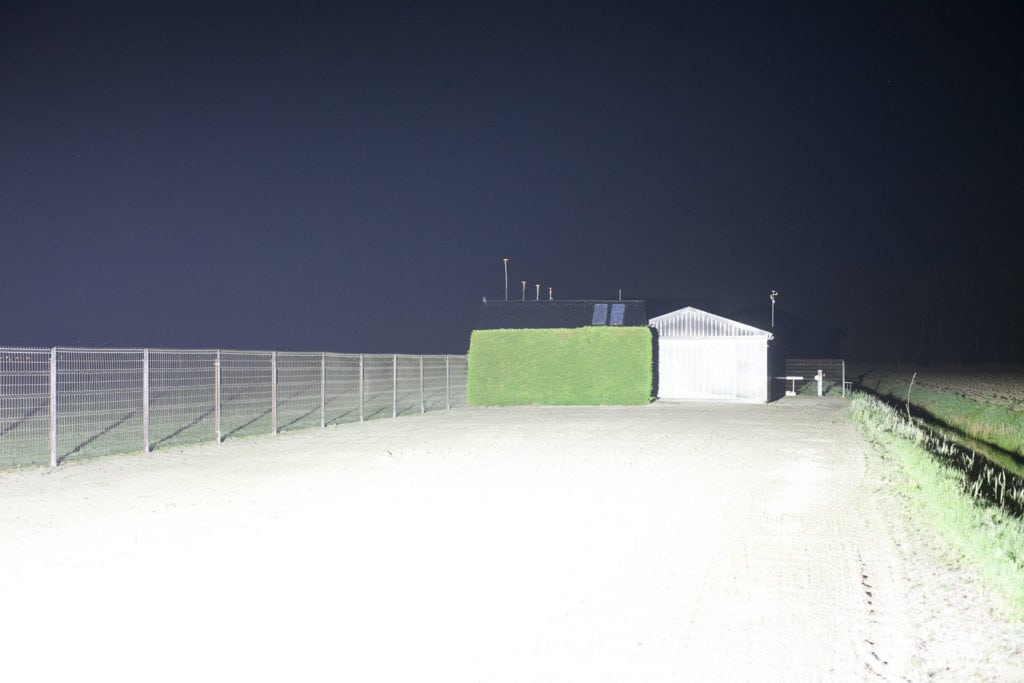
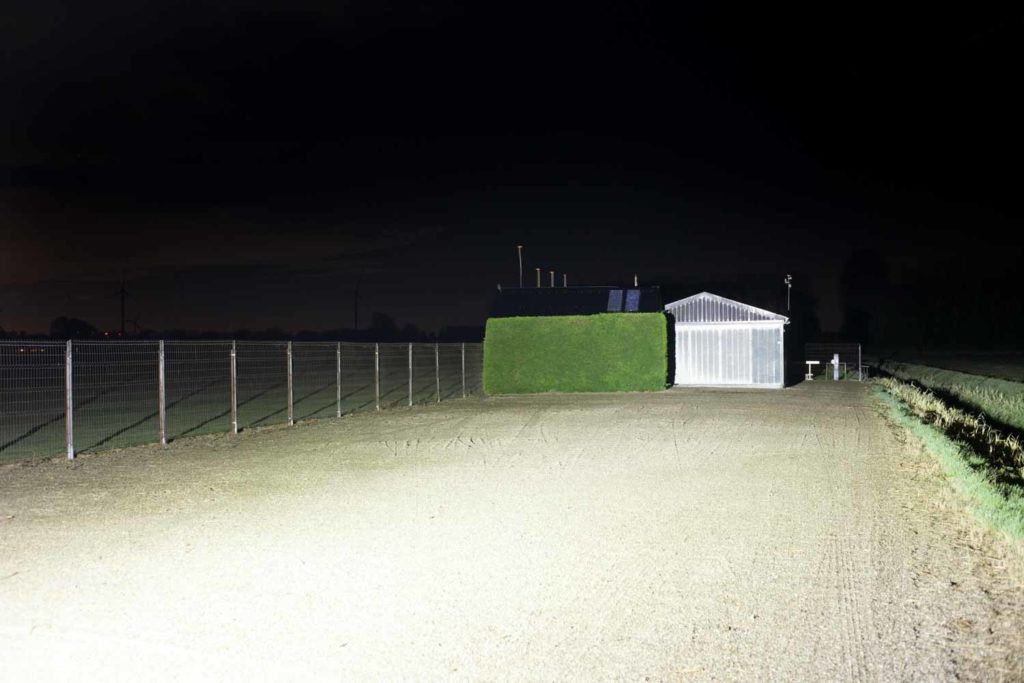
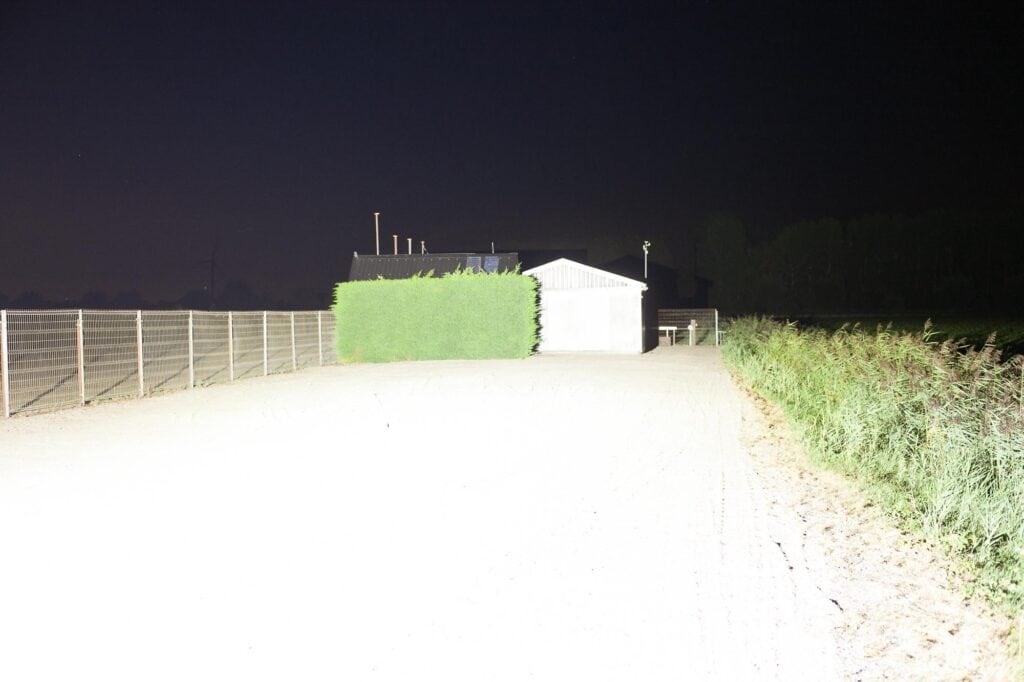
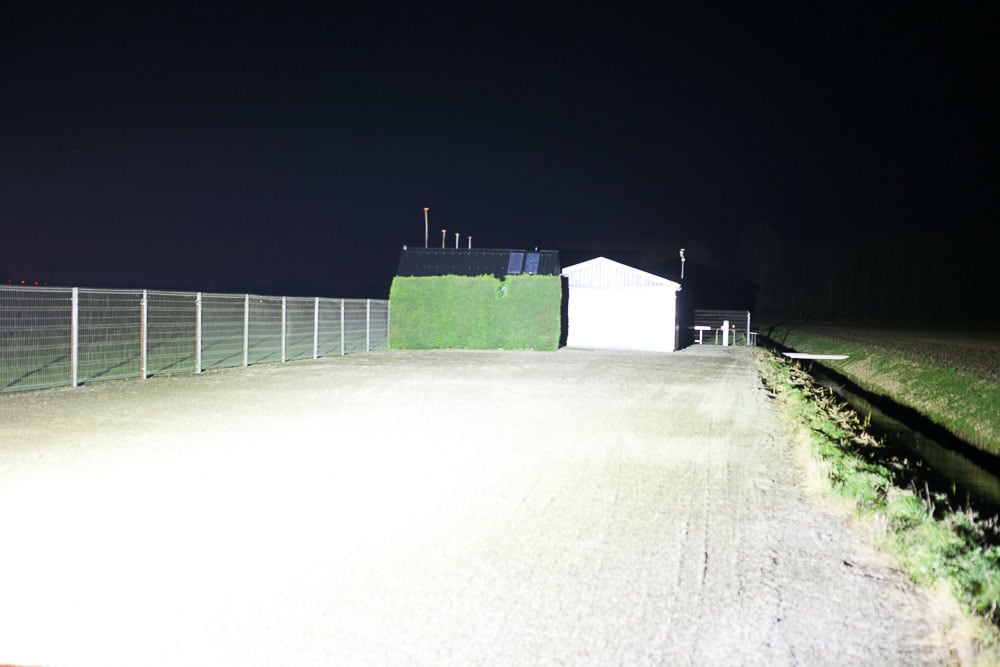
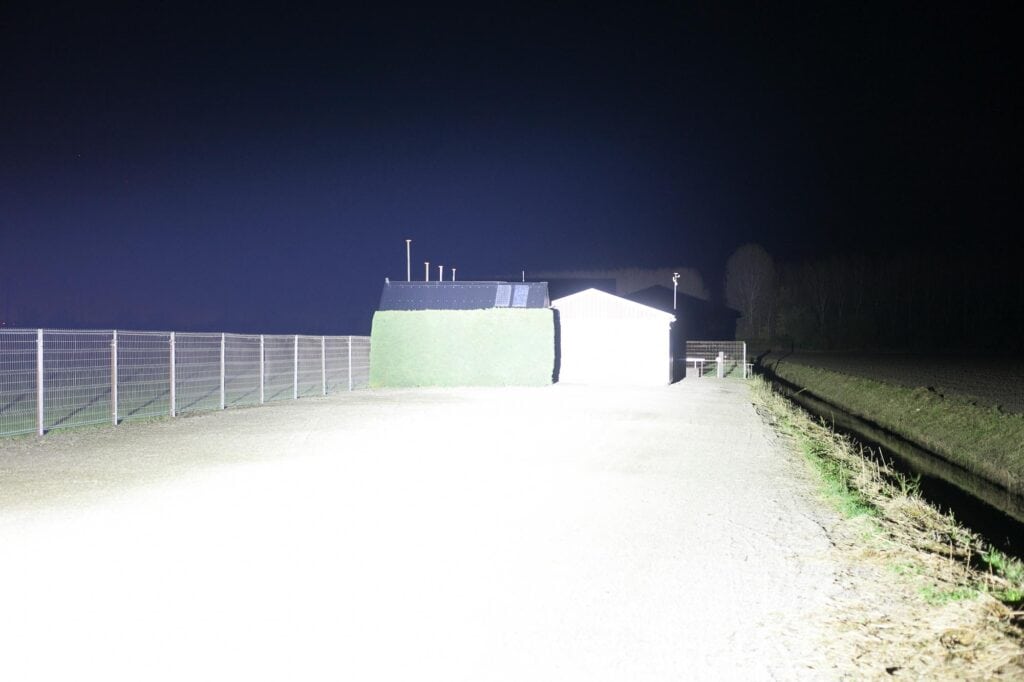
In the following pictures you can see the output mode and the specified output.. which is not the same as in real life, but it’s easier to distinguish the modes that way.

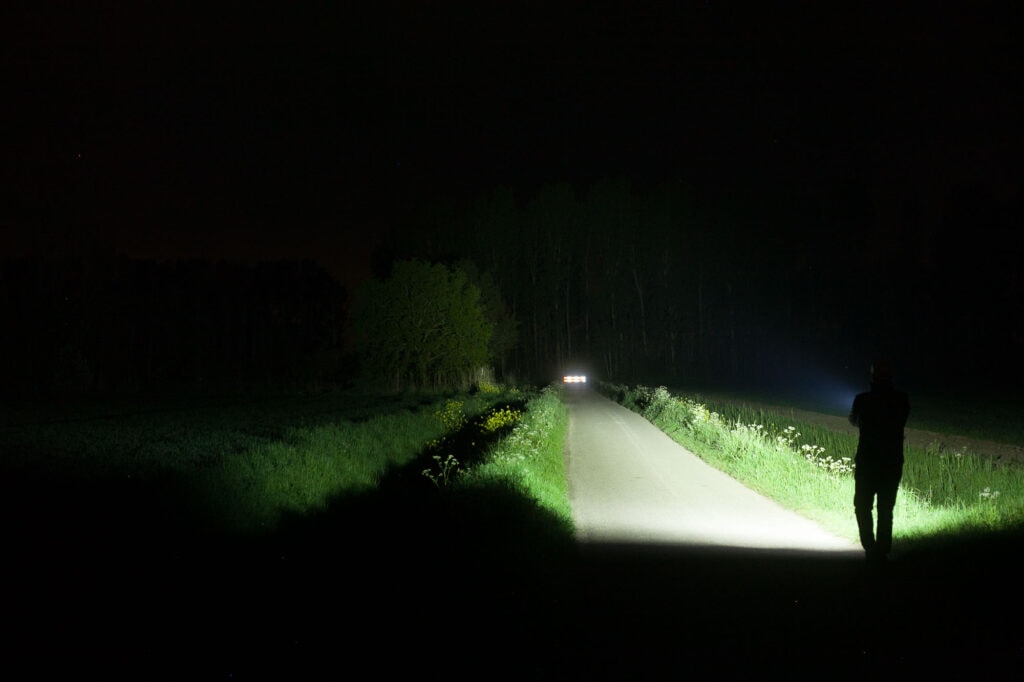
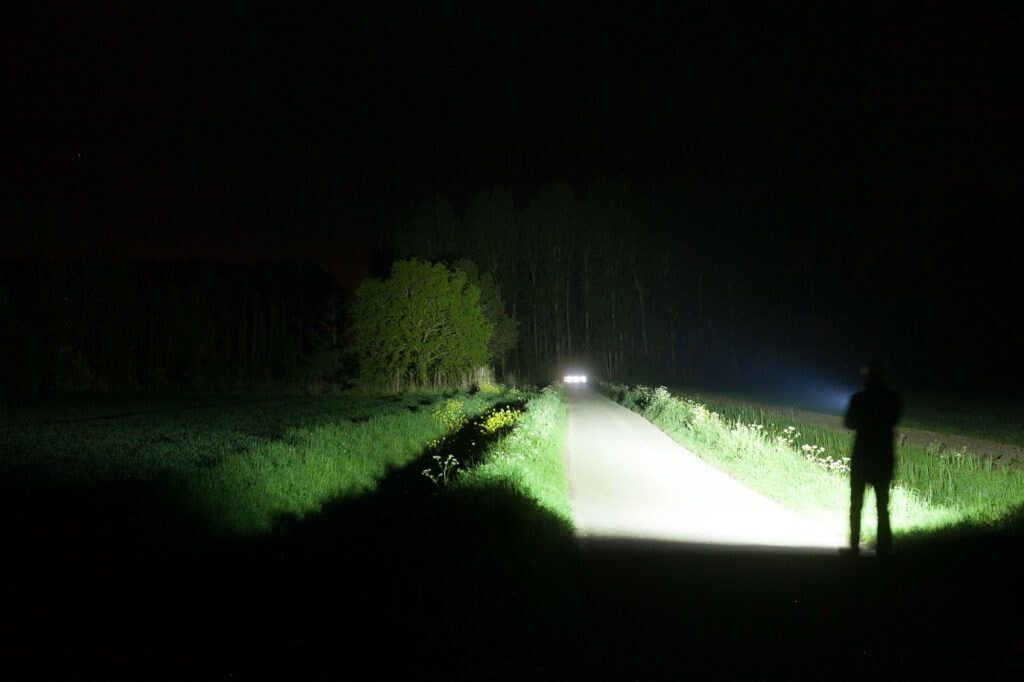
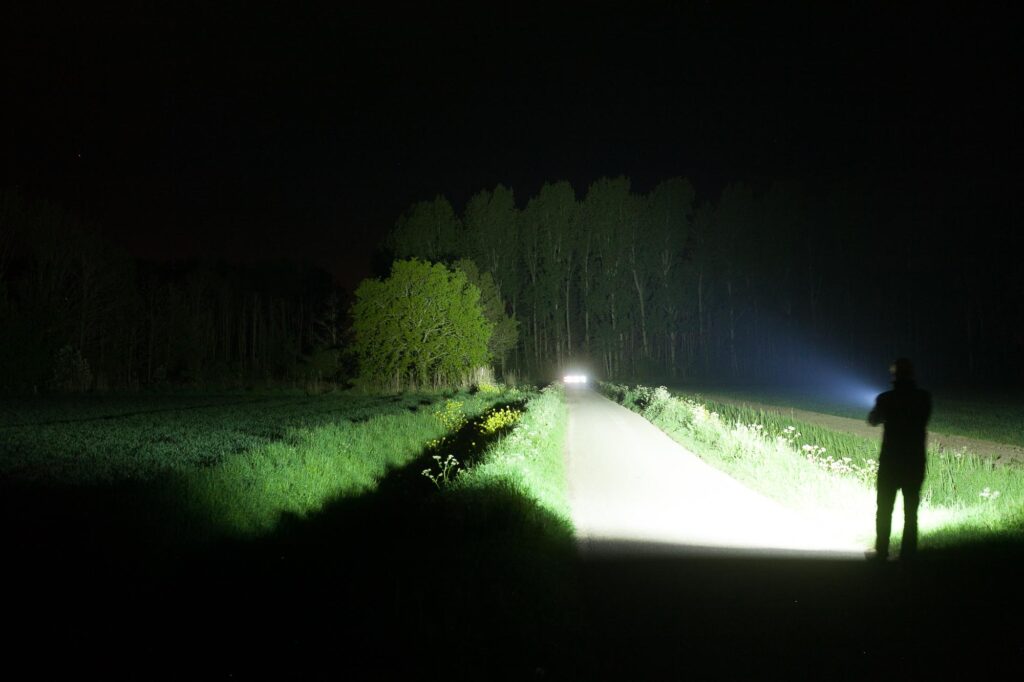
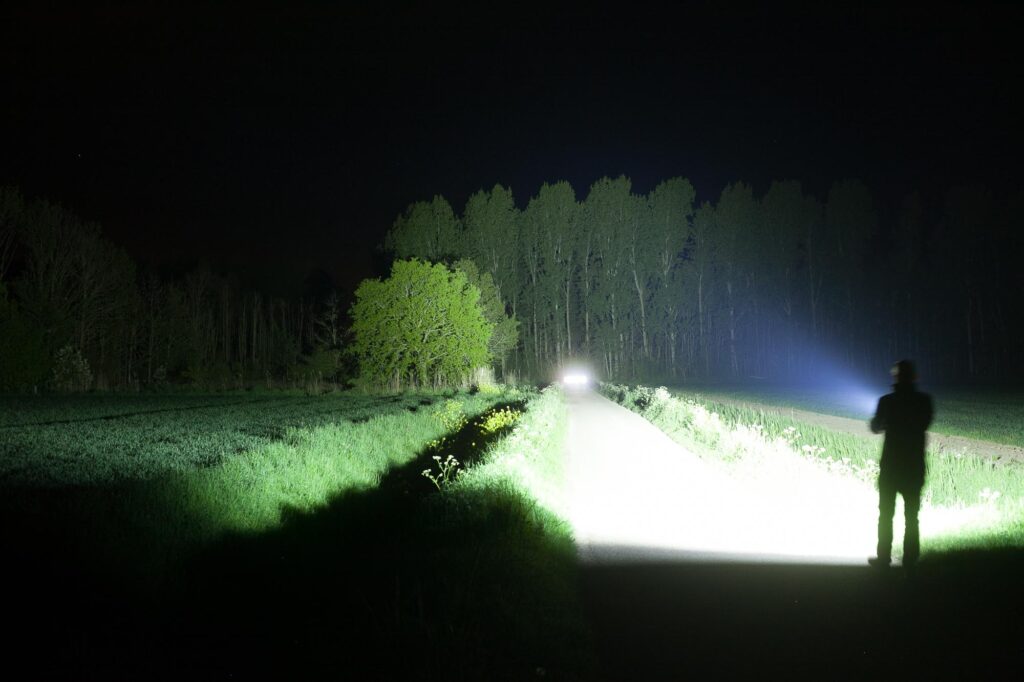
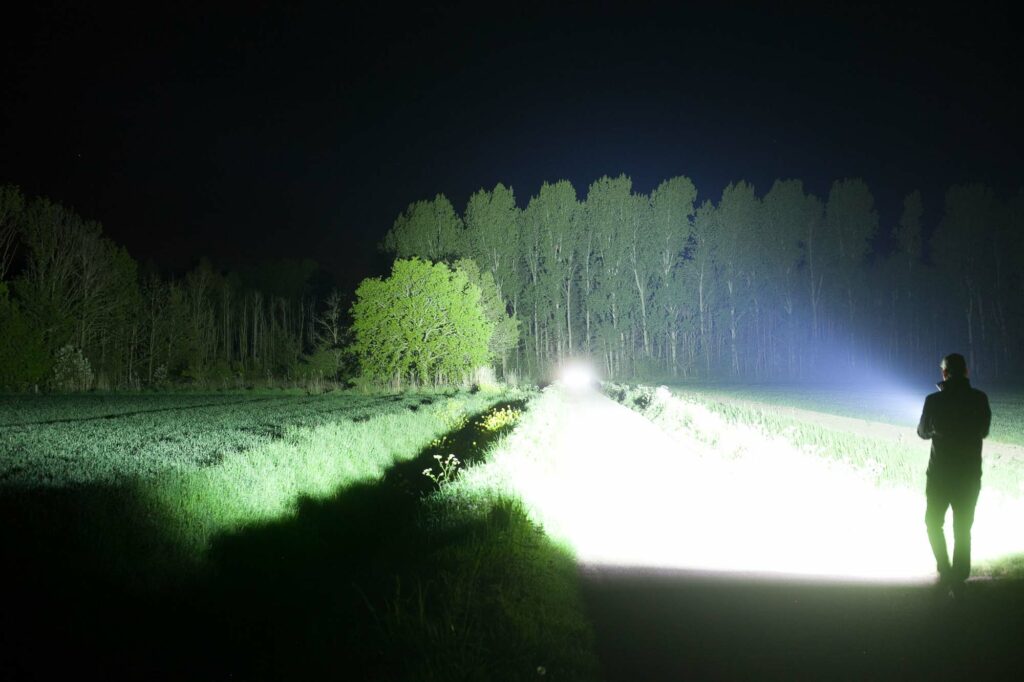

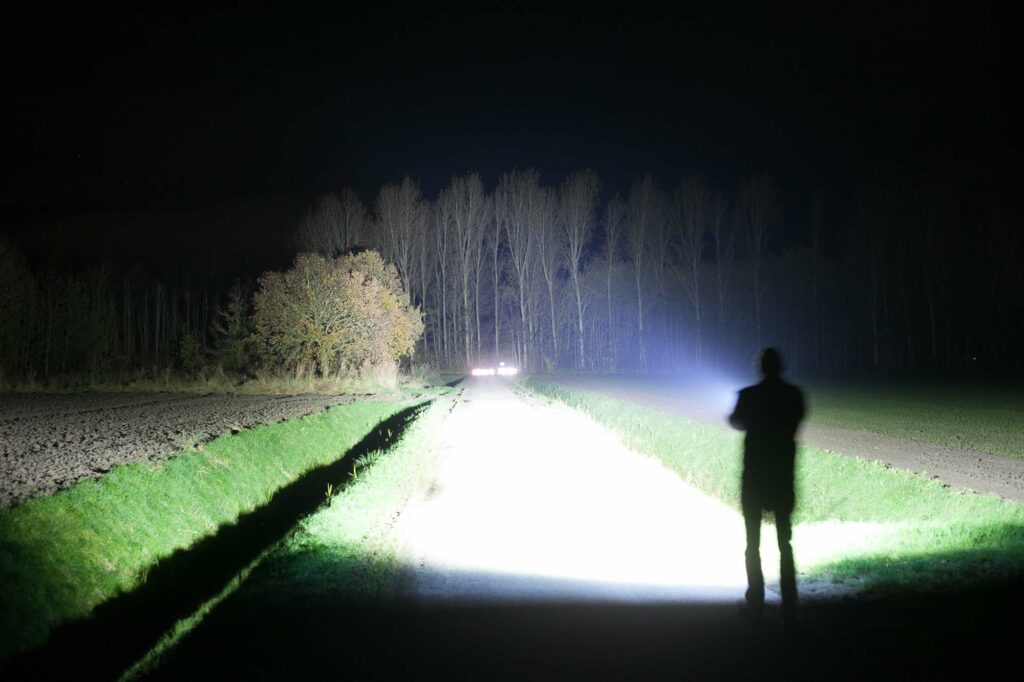



Disclaimer: This flashlight was sent to me for review at no cost by Imalent. I have not been paid to review, nor have I been holding back on problems or defects.
Final Verdict
Pros
- Very powerful, and reaches over 100,000 lumens at turn on
- Insanely bright and good throwing beam
- Turbo can reach almost 90,000 lumens for 50 seconds
- Removable carry handle with built-in switch
- Can be used without the handle!
- Battery pack can be used as power bank
- Can get spare battery packs
- Can charge battery pack when removed from the head
- A real low-output mode (30 lumens)
- Cooling fans work well, to keep the temperature in check.
- Sustains over 17,000 lumens (longer than any other brand/model)
Cons
- No tripod mount
- High mode performs better but has a strange increase and then decrease in output at turn on
- UI! It has mode memory, and no short cut to Low mode, or any other mode except Turbo. A trick is to unscrew the battery pack, and it will turn on in Moon again.
- Screen with current mode turns off within 5 seconds. And you can’t turn it on while the flashlight is turned off to know what mode it is in.
- The display shows when the battery is running low, but nobody is looking at the screen.
- Sensitive for fingerprints etc
- Cooling fans are still pretty loud
Explanation on star ratings:
1: Avoid: my phone flashlight would be a better choice – 2: Poor: significant defect or issues; almost unusable – 3: Average: some defects or issues; but still usable 4: Good: recommended (minor issues) – 5: Great: highly recommended

4 stars: ★★★★
While our star rating provides a reliable indicator, we encourage you to read the full review to make an informed decision based on your own needs and preferences.
Note: since posting this review initially, there had been 2 reports of SR32 lights with burned LEDs. Imalent is taking care of this. So you don’t need to worry. The new SR32 I received has improved performance, and I updated the review with the much improved measurements
Finally, a flashlight that can beat the MS18. And it took 4 years for Imalent to make something capable of competing with the MS18. But does it actually beat the MS18?
The design has changed quite a bit from the MS18. It’s shorter, has a smooth battery tube, using a very matte finished coating. It also added a nice carry handle with a switch built-in (if you’re right-handed). But the fans are still very noisy, albeit effective in keeping the temperature in check.
Even though it didn’t reach 120,000 lumens, this is still the brightest flashlight on planet earth. It can be almost do 90K lumens for 50 seconds, and roughly 17,000 lumens for almost 50 minutes. No other flashlight can do that!
The UI isn’t very intuitive, and could be improved as well as the charging port cover, and perhaps a clearer low battery warning.
Imalent SR32 discount code
If you order this flashlight from Imalenstore, make sure you add our exclusive coupon code at checkout for an extra 10% off. Coupon code: 1lumen
1lumen selects and reviews products personally. We may earn affiliate commissions through our links, which help support our testing.